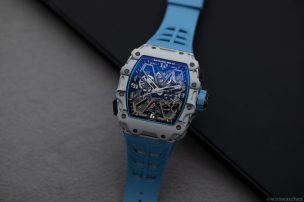
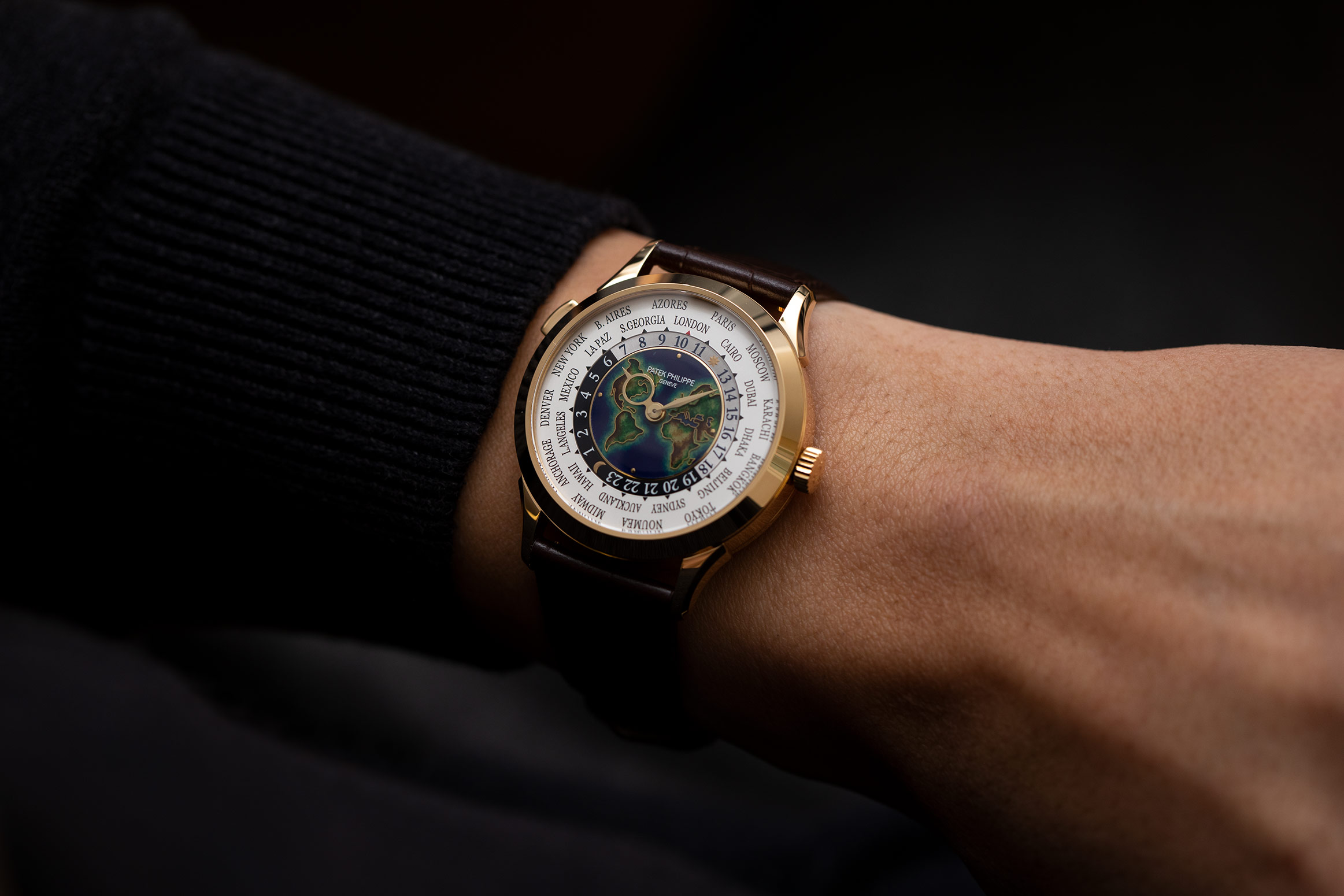
The History of The Patek Philippe World Time Watches
A function on its own is never everything. This is not exclusive to watchmaking, but it is particularly true here. Take a watch, for example, with which you can dive thousands of meters deep (at least if you wanted to, and your body could get that far down). Or take the function that helps you to measure lap times – provided that you have a race car with which to use it.
It’s no different with Patek Philippe’s World Time watches; the Reference 515 HU – HU standing for „Heure Universelle“ – is considered the manufacture’s first of its kind. It dates back to 1937, a time when long-distance travel remained a luxury reserved for the elite. Travel was something so cost-, risk-, and time-intensive that only the worldliest gentlemen were able to do so. So knowing the local time in Calcutta or Sydney thanks to your watch? This brought very few real benefits. But then, over the decades, the world began to move increasingly close together, culminating in the culture of international frequent flying we indulge in today. Pretty much everyone began travelling with Boeing or Airbus, and the complication of a World Time watch suddenly seemed very useful indeed, both for those traveling between time zones and those staying at home.
Of course, mobile phones became at least as practical a way to find out the required local or home time – they are just not as nice to look at. But then, in the spring of 2020, the world stopped. Instead of wandering far and wide across the world, every single person found themselves suddenly at home. Thus, Patek Philippe’s World Time watches became what, in a way, always made them so special: they were pieces of fantasy. A piece of craftsmanship that makes one dream when looking down at one’s wrist. Would it be cocktail hour in the Maldives now? What might that business partner in New York be doing right now? Where is the sun over Cairo right now? The complication makes a globetrotter out of every owner, no matter how attached he or she may be to their homeland.


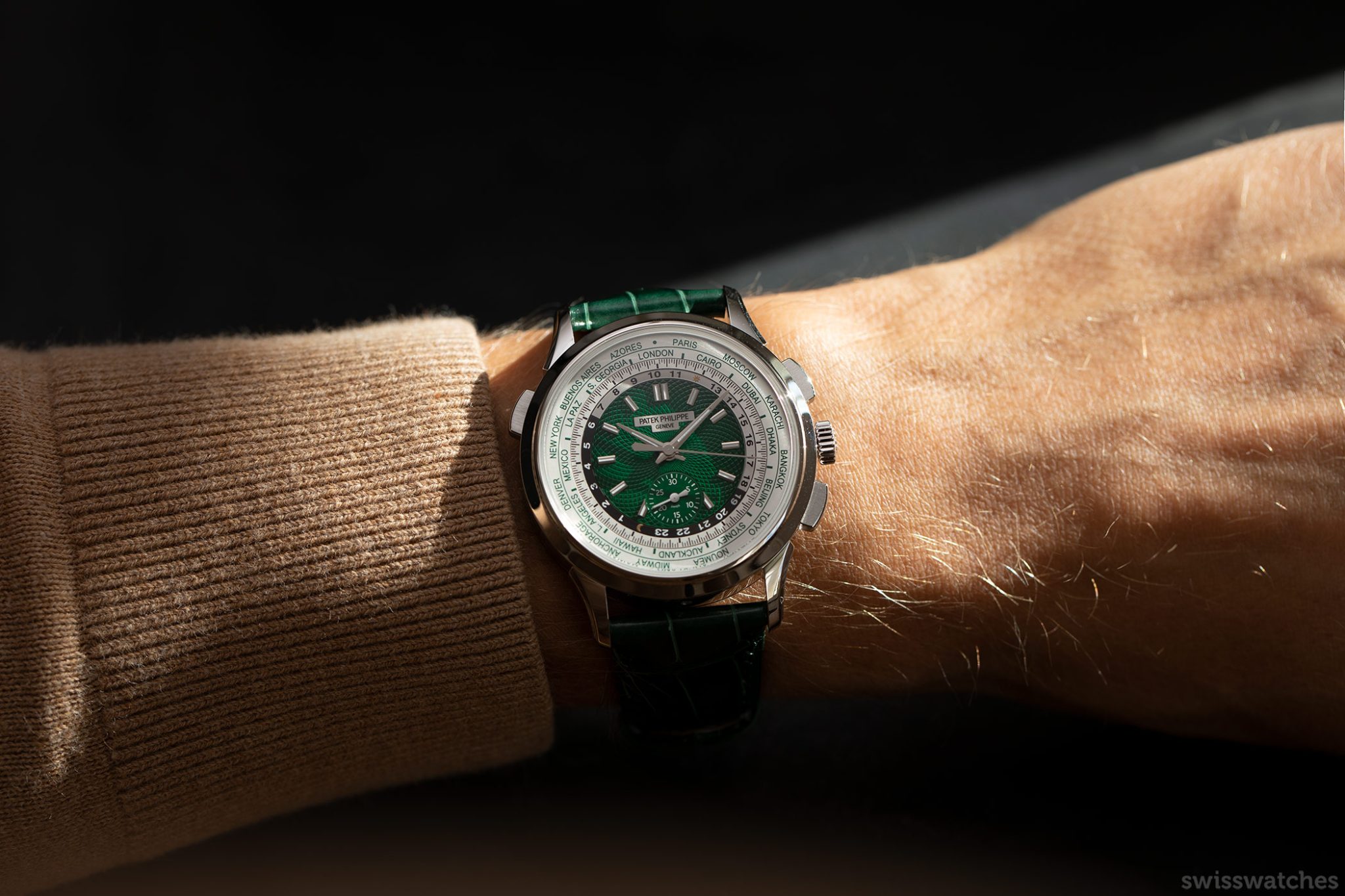
Patek Philippe reference 5930P-001 in platinum
A modern world time watch with flyback chronograph and automatic winding
Current Collection of Patek Philippe World Time watches
The 1930s and the start of a new way to read time:
Reference 515 – the first Patek Philippe World Time wristwatch
We should keep in mind that not even two hundred years ago, every larger region ran on its own time. This was determined with the help from the position of the sun; when the sun was at its zenith, it was twelve o’clock noon. This was as simple as it was precise. However, this became more complicated as railroads became more common. All the different times in different places made creating coordinated schedules increasingly difficult. Therefore, in 1884, at the International Meridian Conference in Washington D.C., it was agreed for the first time that the world should be divided into 24 time zones. The Greenwich Time Zone was defined as the prime meridian. From then on, at least mathematically, each time zone corresponded to 15 degrees of longitude.

It was not until 1931, however, that independent watchmaker Louis Cottier managed to find a corresponding watchmaking solution for this new world order. It manifested itself in the form of his „Heures Universelles“ design. At the centre of his first World Time watch was an inner ring divided into twelve hours, an outer ring with 24-hour markers, and 31 cities to represent respective time zones.
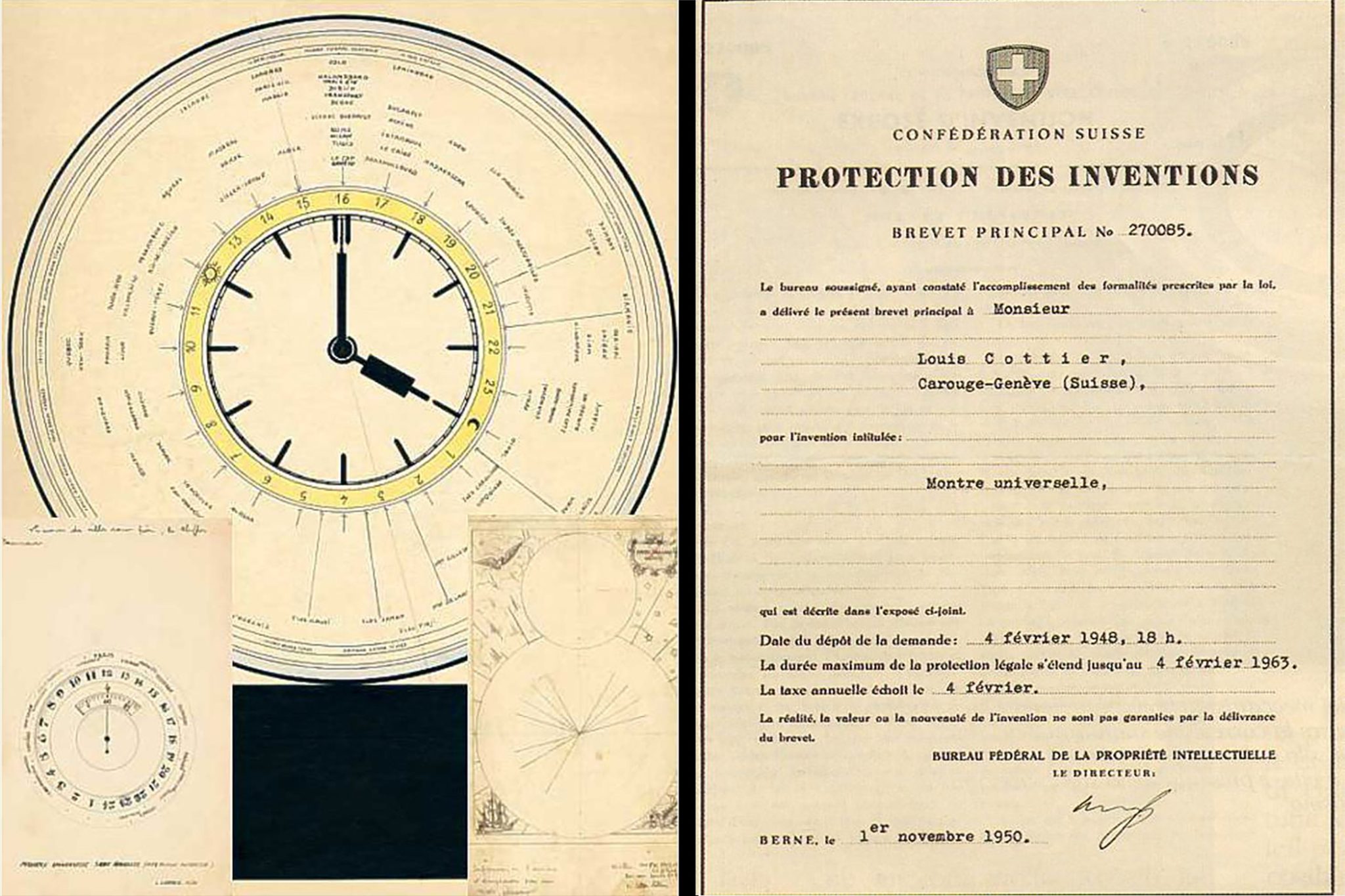
This complication, which was put into a pocket watch for the historic jeweller Baszanger, attracted the attention of the major watch manufacturers of the time. Amongst them was Patek Philippe. Together with Cottier, the horology house went on to produce the first Patek Philippe world time wristwatches in 1937, in the form of the red gold Reference 515. Presumably, only four prototypes were made at the time in a rectangular Art Deco case.
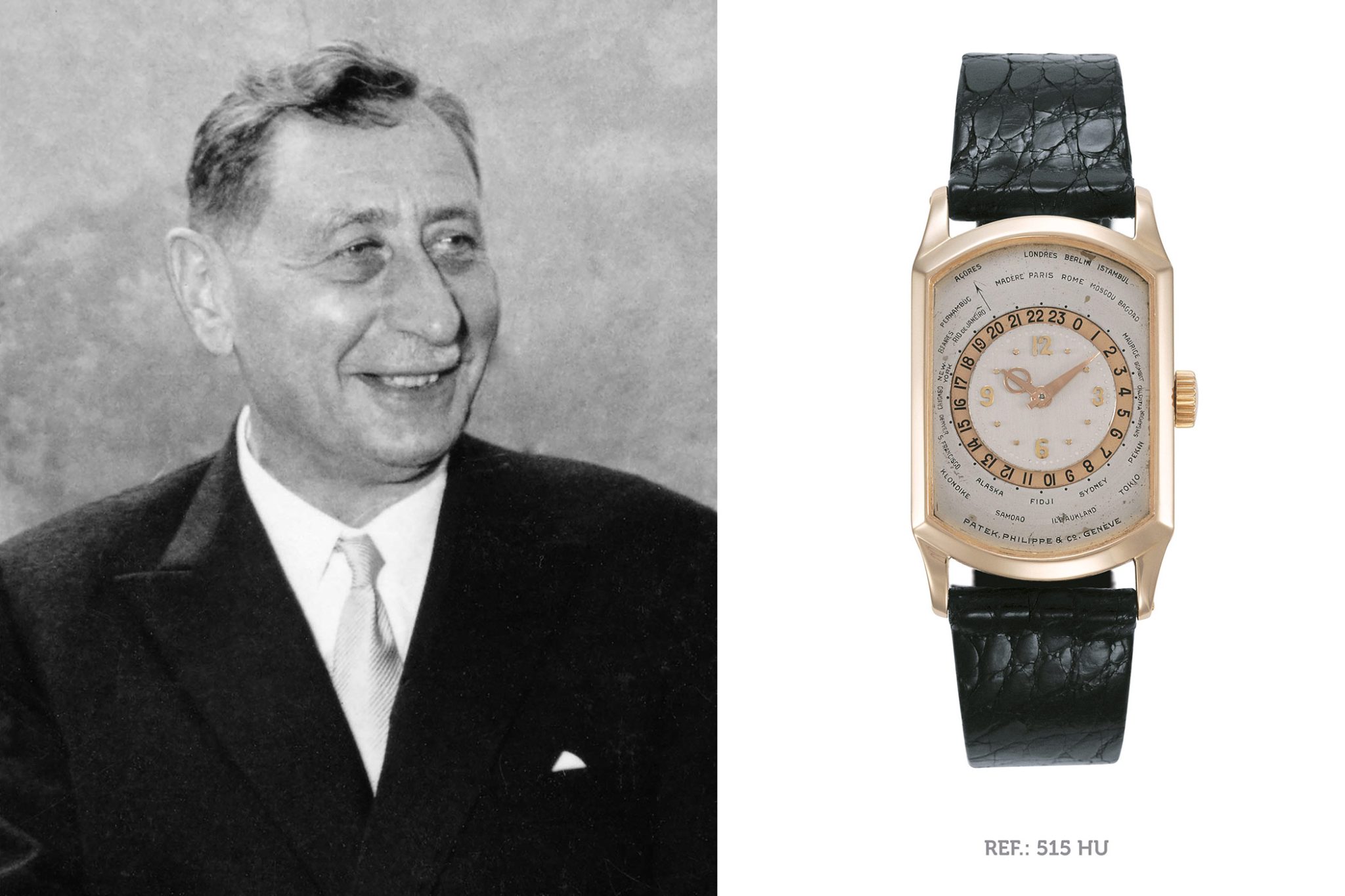
Louis Cottier. Credit: Jean-Pierre Cottier
The Patek Philippe Ref. 515 HU – HU stands for “Heure Universelle”.
At this point, it is worth stopping for a moment to reflect. Today, the brand Patek Philippe enjoys such a high level of prestige, given the strength and hype surrounding some of its current models, that one might almost forget that its legendary reputation is deeply rooted in the past.
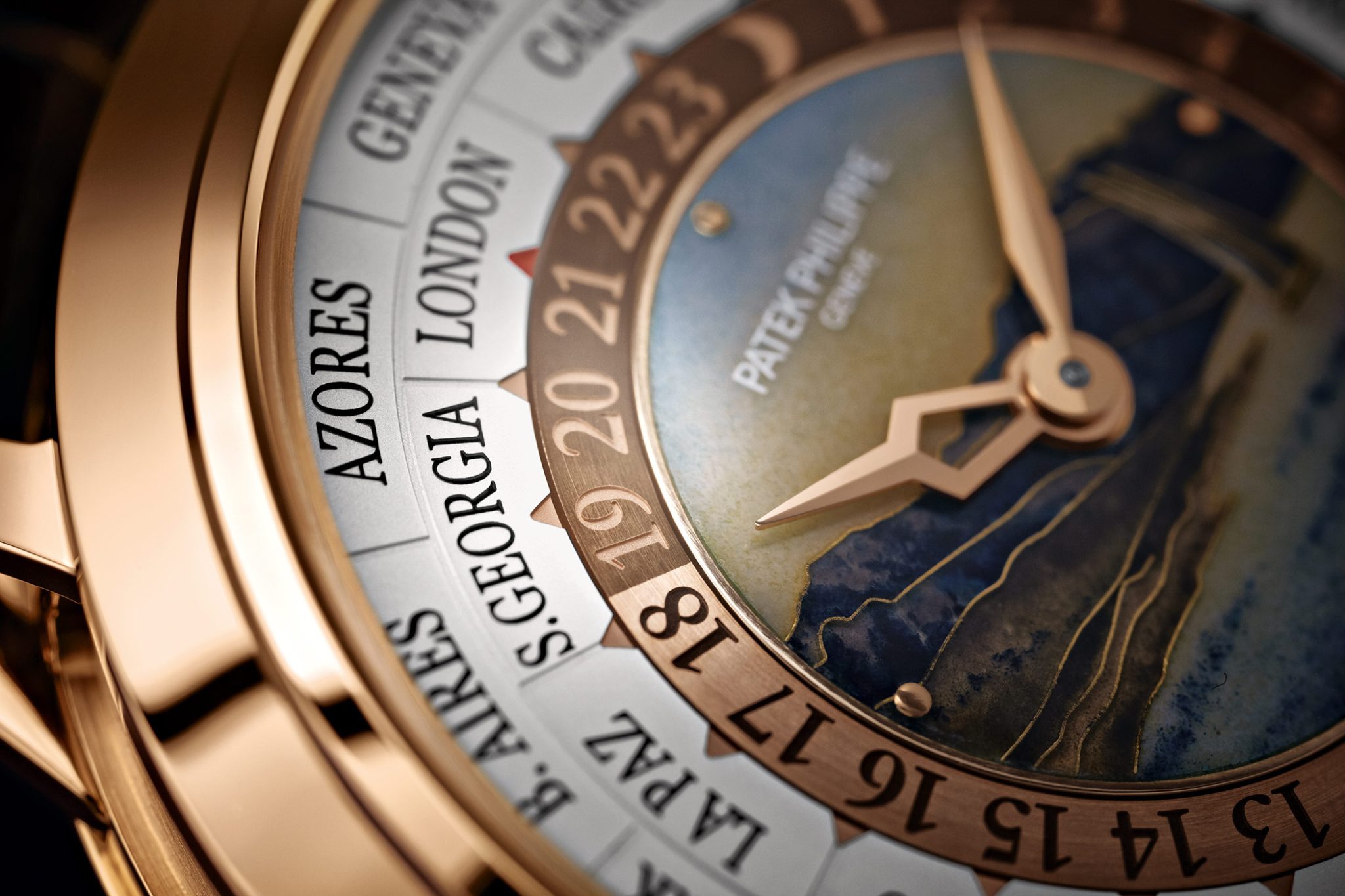
Patek is firmly associated with the development of the perpetual calendar, with many considering the combination of this complication and the hand-wound chronograph to be “typically Patek Philippe”. By contrast, its Calatrava models epitomise elegant dress watches. Meanwhile, the Nautilus is another legend whose significance articulates itself in the form of great desirability, with soaring prices at auctions and on the secondary market. With its countless horological feats, Patek is also responsible (together with Louis Cottier) for the first World Time wristwatch. No wonder, then, that World Time watches from Patek Philippe still have a very special appeal today, attracting an equally special clientele of collectors within the maison‘s catalogue once more.
The 1940s and 1950s:
Constant striving for improvement
While the first model, Reference 515 (with its fixed time zone ring with 28 locations) was synchronised solely to Greenwich Mean Time (GMT), this was no longer a constraint for the Reference 542, appearing shortly after. The watch, with its engraved rotating bezel, featured 30 locations. With a case diameter of just 27,1 mm, it is known as the first individually adjustable world time wristwatch. Also worth a mention is the 30,4 mm Reference 96 HU in yellow gold. Only two models are said to exist – one of them, incidentally once belonging to Jean-Claude Biver, was auctioned in 2020.
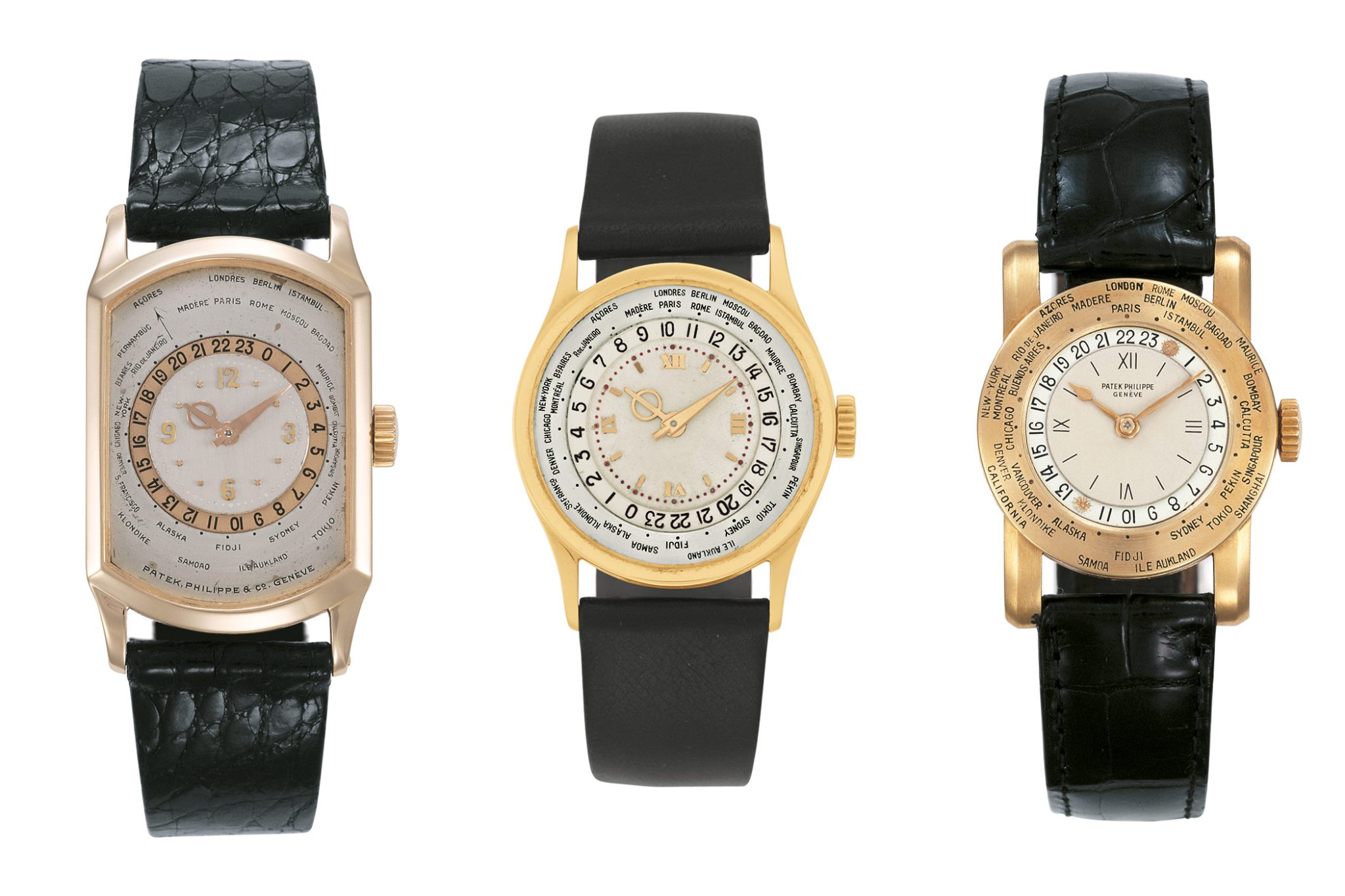
Patek Philippe World Time watches from 1937:
Ref. 515HU – Ref. 96HU – Ref. 542HU
In collaboration with Cottier, these watches destined the jetsetters of the future became an increasingly important matter for the manufacture. In 1939, Patek presented the Reference 1415 HU; the first “mass-produced” world timepiece. By today’s standards, though, we are talking about a mini-series. The numbers of pieces of the 31 mm model, which was in production until 1954, are still very straightforward, with collectors assuming there to be a total number in the very low three-digit range. Only one platinum model is known to exist, and was auctioned off in 2002 in a fierce bidding war for 6.6 million Swiss francs. This set what the then-world record as the most expensive wristwatch of all time. This year, the unique piece was then put up for auction again at Christie’s in Hong Kong and achieved a selling price of 14,650,000 Hong Kong dollars, which is equivalent to around 1.7 million Swiss francs.
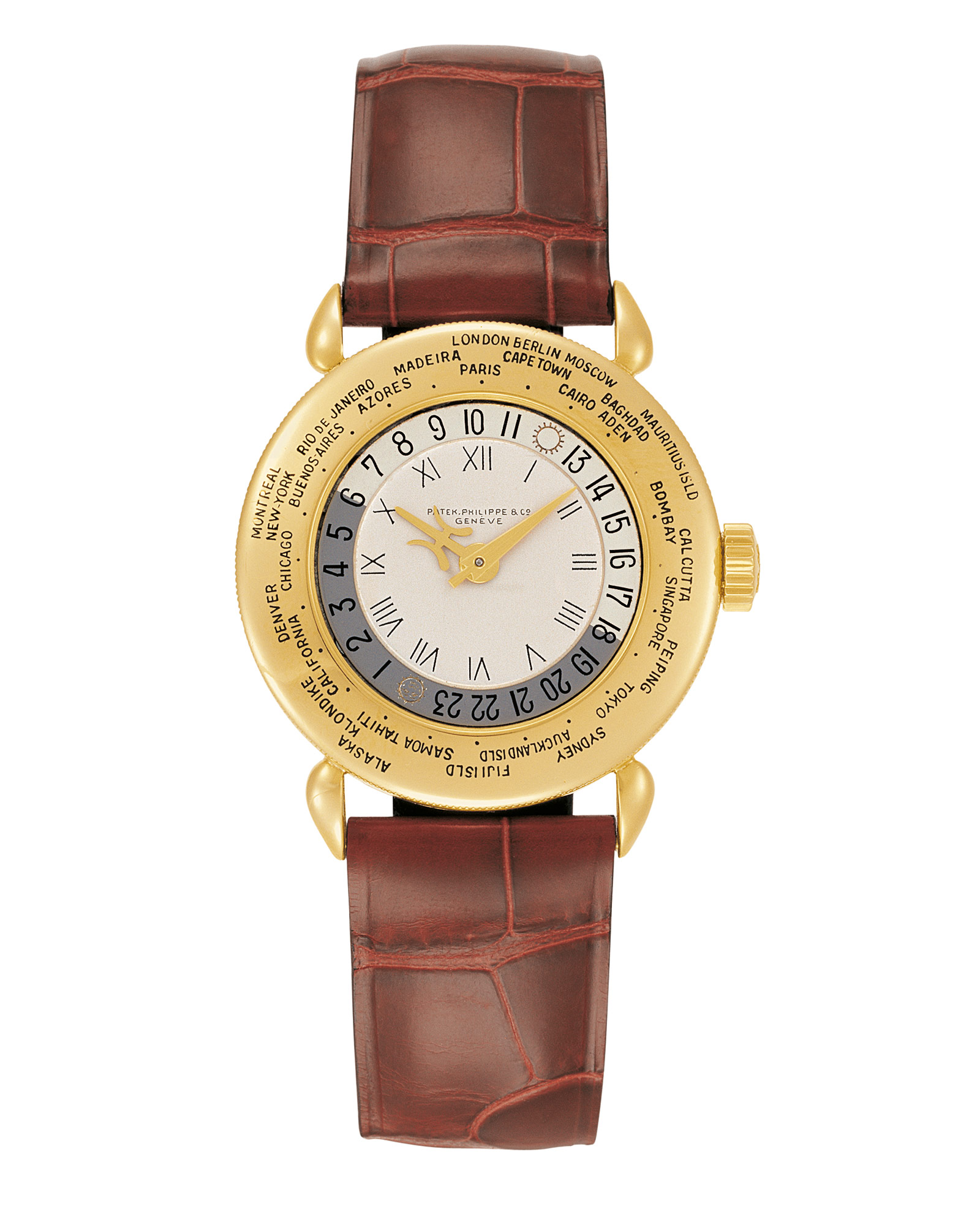
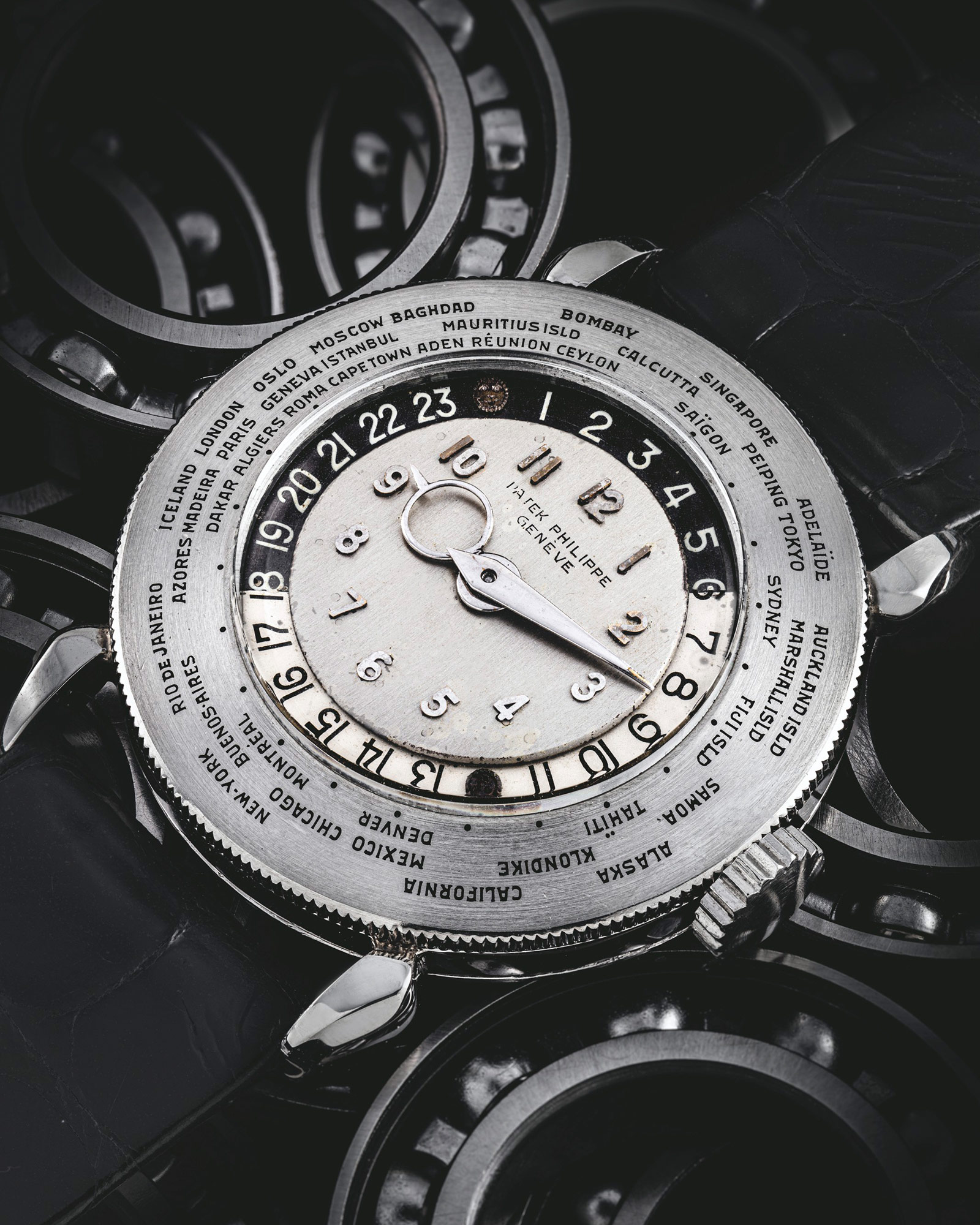
1939 – Ref. 1415 HU – The first world time watch produced in series (left)
1946 – Ref. 1415 HU in Platinum (right) – Credit: Christie’s
Incidentally, the watch was also combined with a chronograph at the request of a customer (the 1940 Reference 1415-1 HU), playing a formulative role in the current collection – but more on that later. Additionally, together with Cottier, Patek came up with a model with a second crown and an internal city name rotating bezel, presented in 1954 in the form of Reference 2523 HU. With the crown at nine o’clock, the respective local time on this model is set via the rotating disc with 41 city names. To this day, this technique with an internal city name rotating bezel is used not only by Patek Philippe, but also numerous other manufactures.
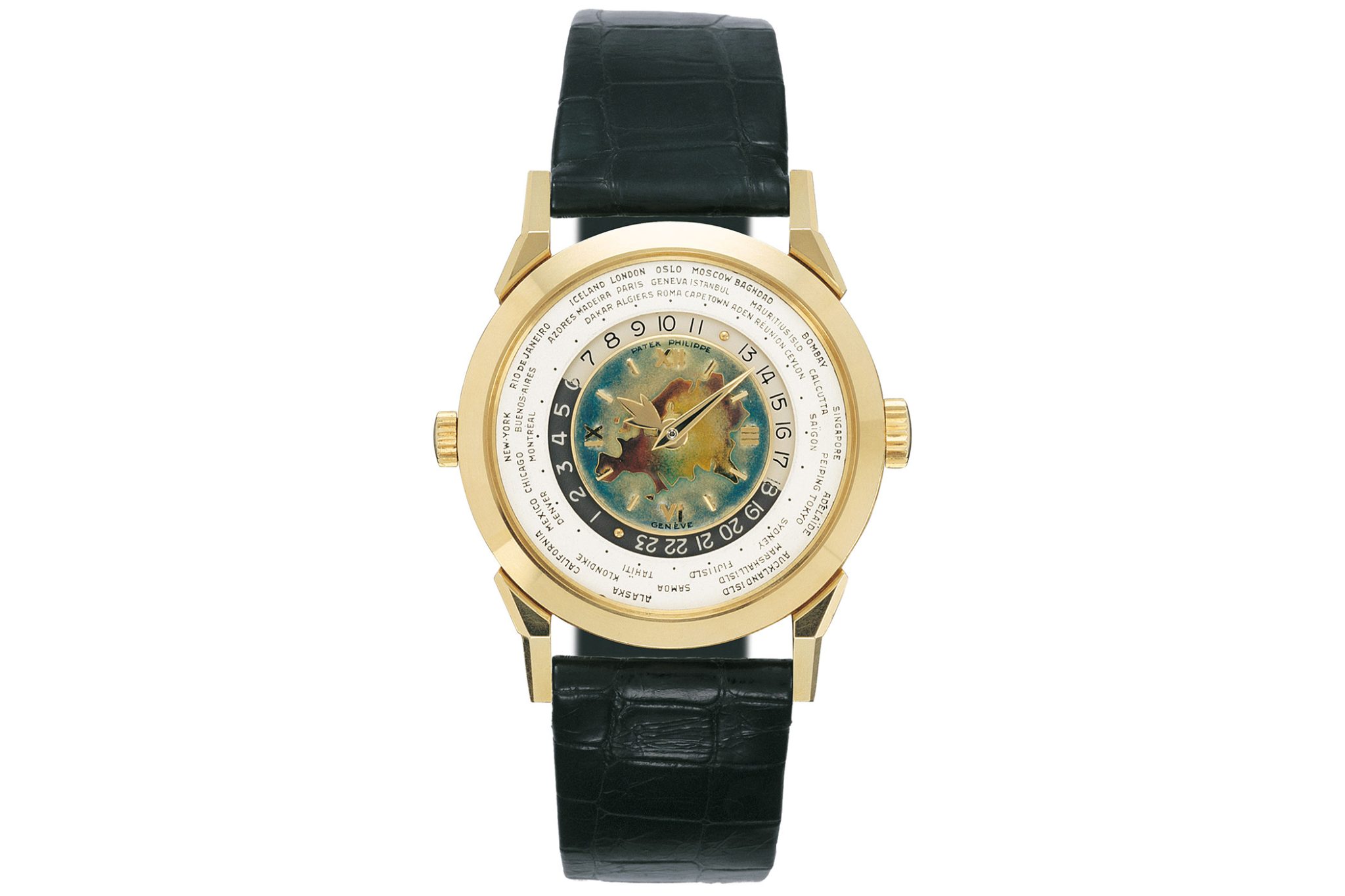
Patek Philippe Ref. 2523 HU from 1955
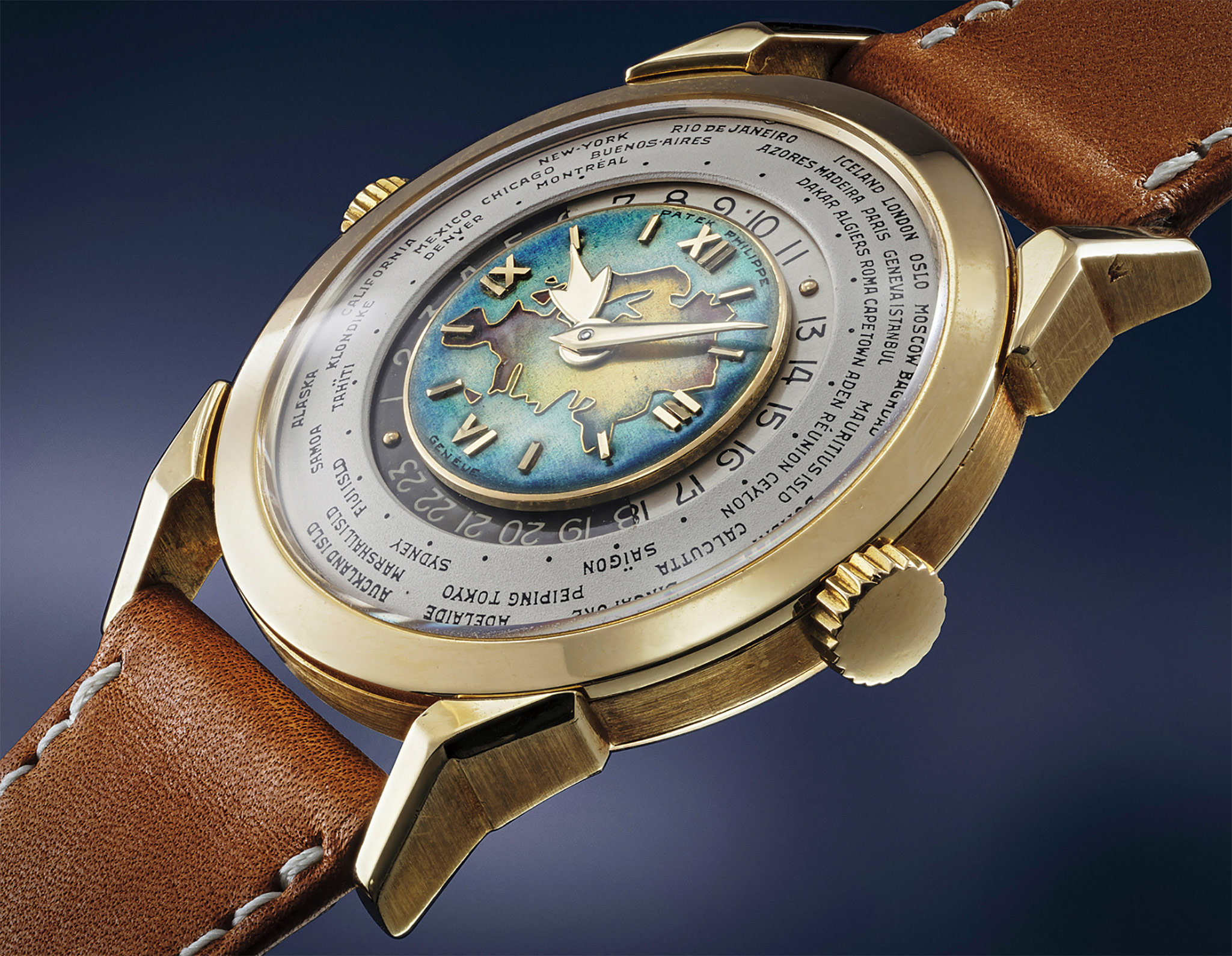
Patek Phillipe Ref. 2523 “Silk Road” from 1953
Credit: Phillips
From Moscow to Munich: time zones and their titles
The city names upon the bezels of historical Patek Philippe models are fascinating in their own right, with the dials reflecting the state of global geopolitics across the past decades despite mere centimetres of space. In the past, time zones have shifted time and time again for political and economic reasons, and the naming of a city as the representative of its time zone is an indication of its power at the time. For example, the fact that Münster, rather than Paris, appeared on exactly 32 pieces of an anniversary Reference 5110 from 2006, for the Patek Philippe concessionaire Oeding-Erdel, might be obvious.
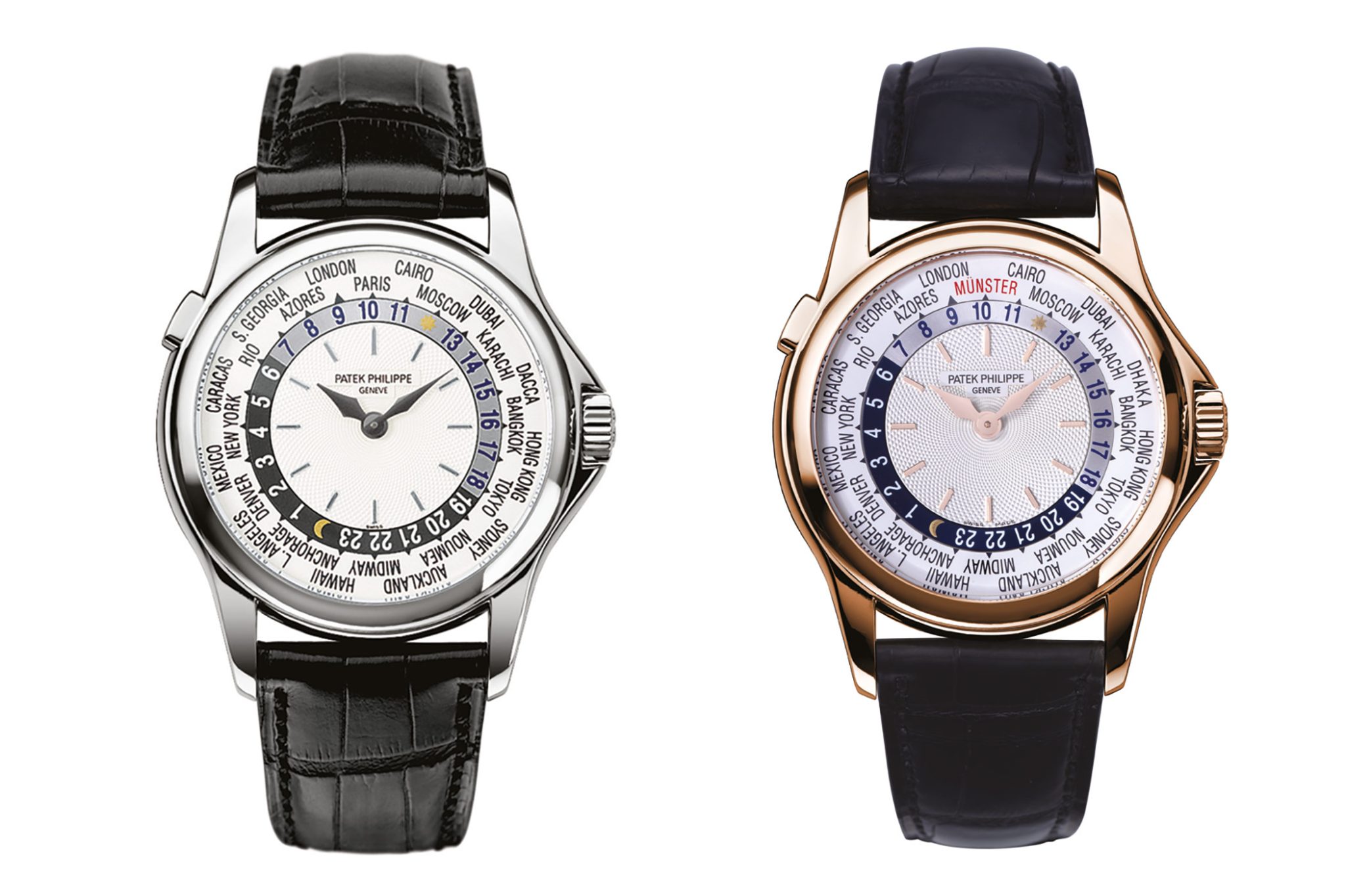
Patek Philippe World Time watches:
Ref. 5110G and Ref. 5110R-011 for Oeding-Erdel from Münster
Or the fact that there was a limited series of 150 pieces of the Reference 5130P-015 produced in 2011 for the Arabic region, on which “Mecca” was printed in green lettering. The same thing happened with the cities of Singapore, Doha, Bogota, and Taipei. In terms of the history of time, however, it is more complex when, for example, the Midway Atoll ousts Samoa as a representative of the UTC-11 time zone because it enjoyed greater fame in 1942 following a naval battle. Or, more recently, when Dubai replaces the Saudi Arabian capital Riyadh due to its growing popularity – as happened in 2016 with the introduction of Reference 5230.
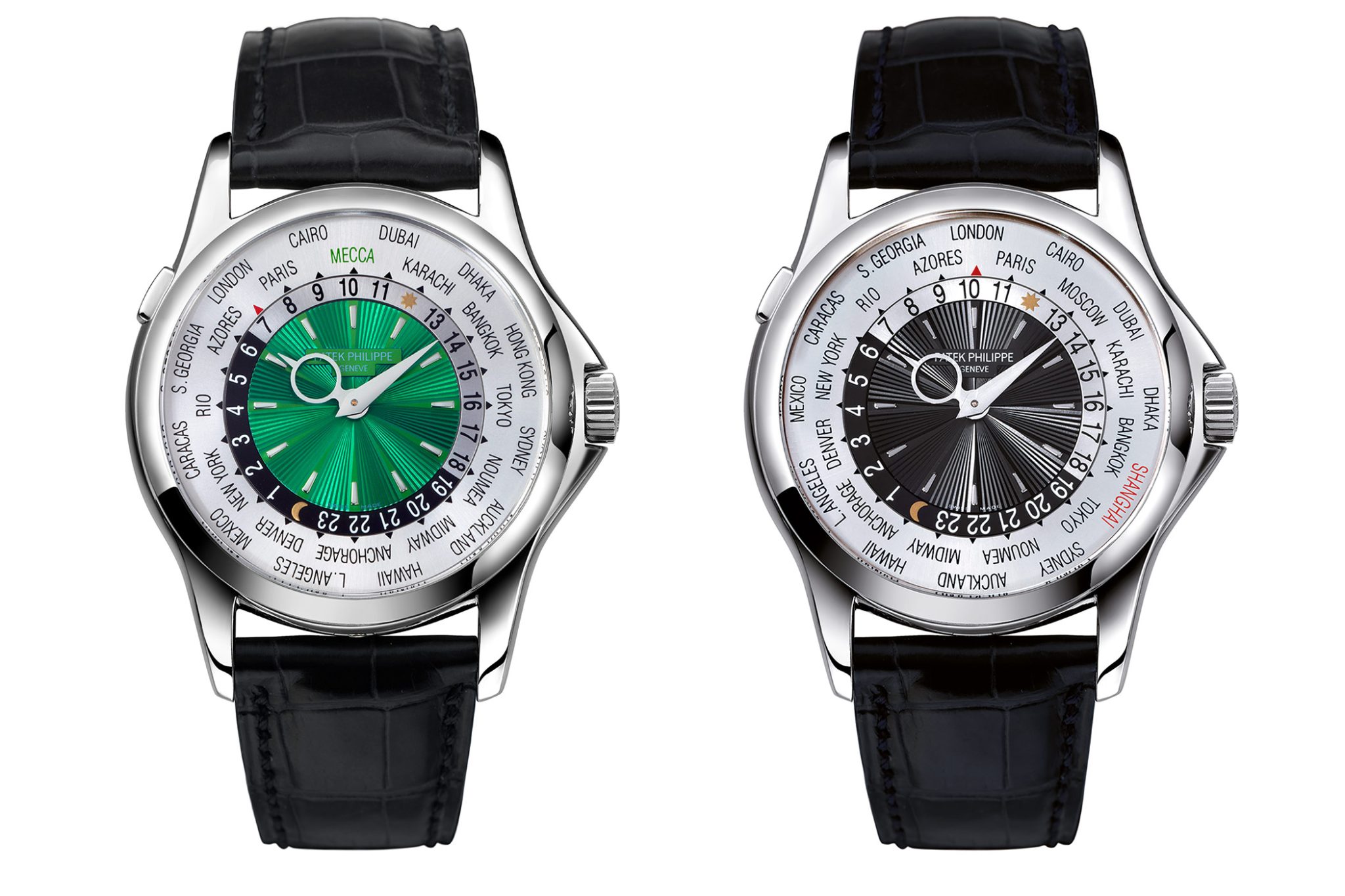
Patek Philippe World Time watches
Ref. 5130P-015 and 5130G-018
For the KunstWerkUhr exhibition in 2013, a corresponding version appeared with the two References 5130R-020 and 5130G-020, featuring a moveable local disc with the blue inscription “MUNICH”. The dial centre with guilloché decoration was decorated in the style of the Munich coat of arms. Finally, the two special models, limited to 25 pieces, were fitted with the automatic calibre 240 HU.
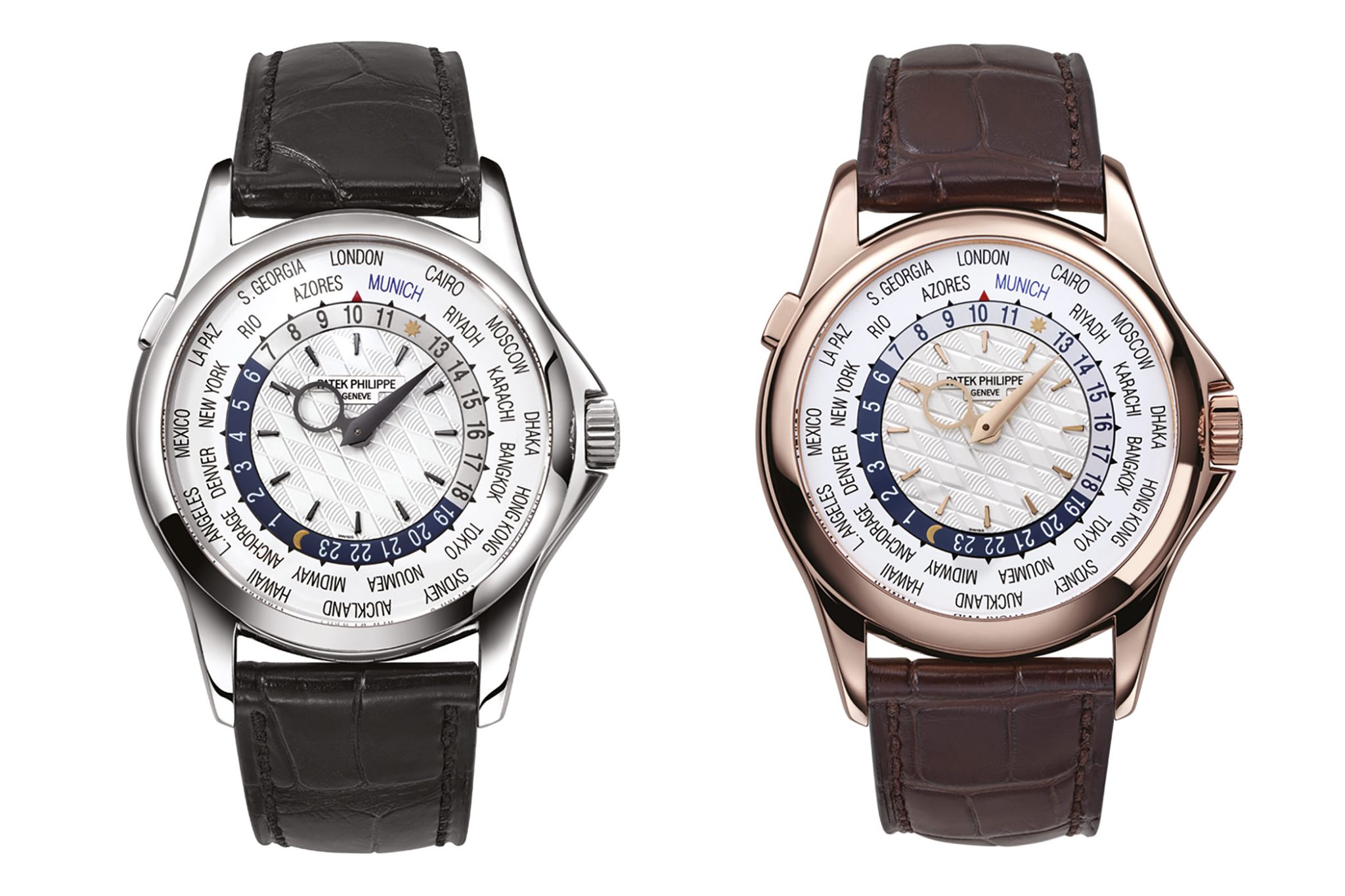
Patek Philippe World Time watches
Ref. 5130G-020 and 5130R-020
The 21st Century: The World Timer in its youth
With the passing of Louis Cottier, World Time watches also disappeared from the Genevan manufacture’s catalogues for the next three decades. The 70s and 80s came and went, the Concorde thundered across the sky with its supersonic boom from Paris to New York and back again, and when the flight company Pan Am also disappeared from airports at the start of the 90s, it became increasingly easy to hop from A, to B, to eventually C. With growing curiosity, generations of world citizens discovered planet Earth, and finally – in the year 2000 – the platinum Reference 5110 appeared, marking a new modern era of World Time watches at Patek Philippe.
One thing is particularly striking about this model; instead of a second crown at 9 o’clock, this 37 mm reference features a pusher above 10 o’clock. This pusher serves to jump from time zone to time zone – a function, by the way, that Patek patented several years back. Inside the watch (and all those to follow) is the calibre 240 HU, based on the traditional calibre 240. The latter movement was first created by Patek back in 1977, mainly with the Reference 3738 in mind – an extra-thin Ellipse d‘Or. Over the years, improvements were made, including the addition of the Gyromax® balance and Spiromax® spiral.
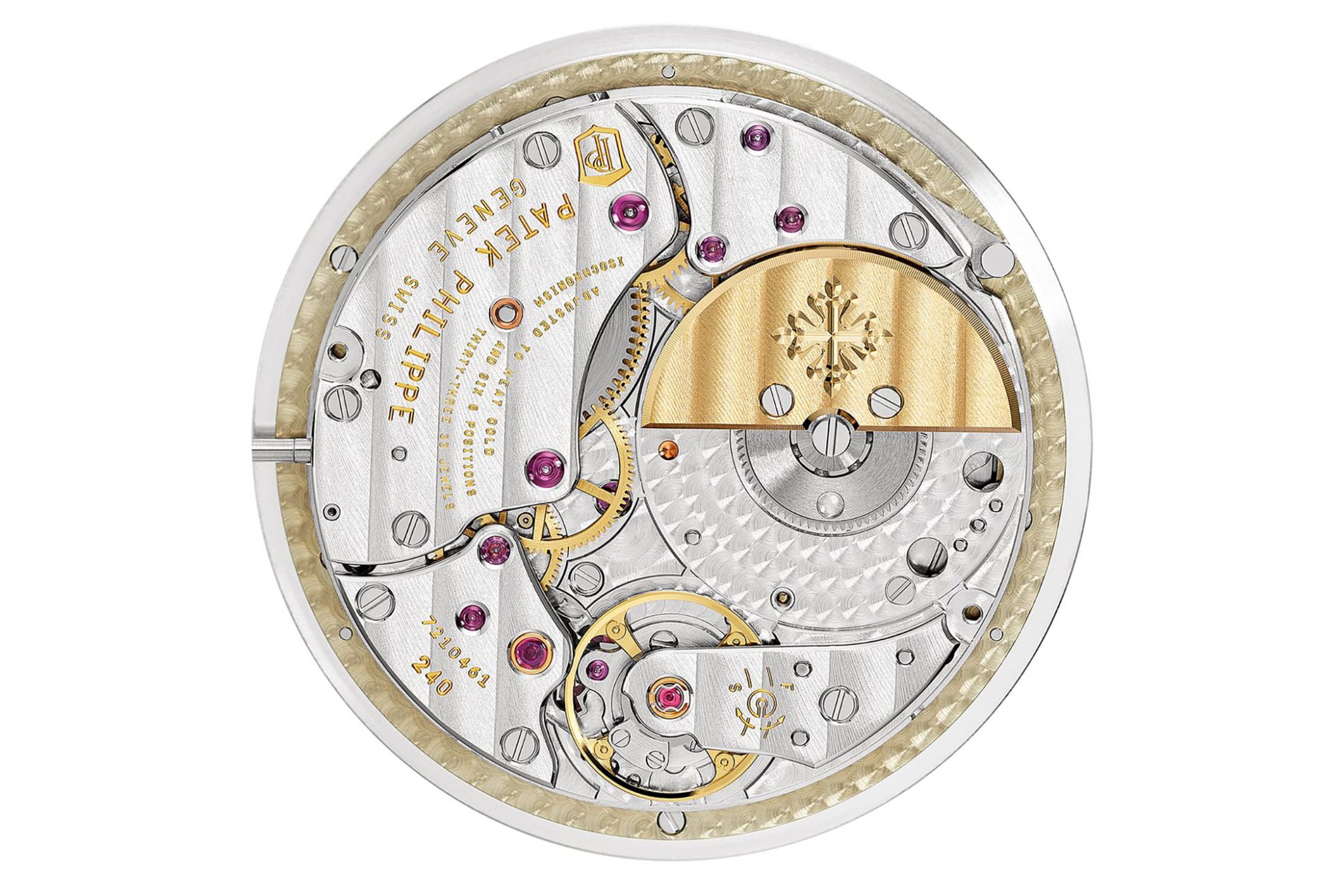
Patek Philippe Calibre 240 HU
With this new Reference, World Time watches made their return amongst horology aficionados. The complication is not just aesthetically unique; many will see it as far superior to any classic GMT watch, and also extremely attractive in terms of craftsmanship. After all, the centre of each dial in particular can be refined and finished in a variety of ways. Patek Philippe started with classic guilloché finishing, before also showcasing cloisonné enamel models on several occasions. The latter was led by the Reference 5131, a variation of the 5130 that had replaced the 5110 in 2006, with a larger diameter of 39.5 mm. The Reference 5130 appears in 2006 in white gold and rose gold. The platinum version of Reference 5130 was first presented in 2007. A mere glance at the enamelled world map on this wanderlust-evoking model inevitably captivates any who sees it in the metal.
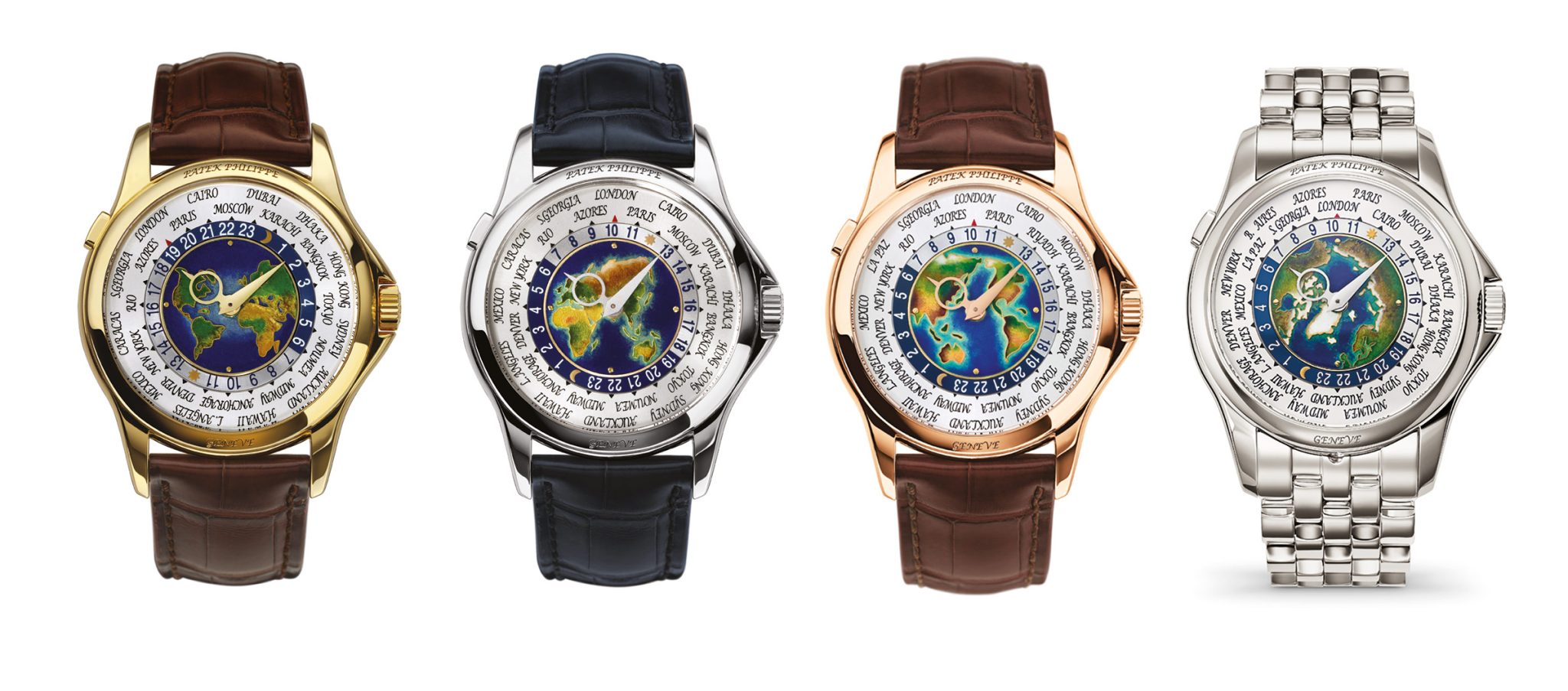
Patek Philippe World Time watches (from left to right)
Ref. 5131J-001, 5131G-001, 5131R-001, 5131-1P-001
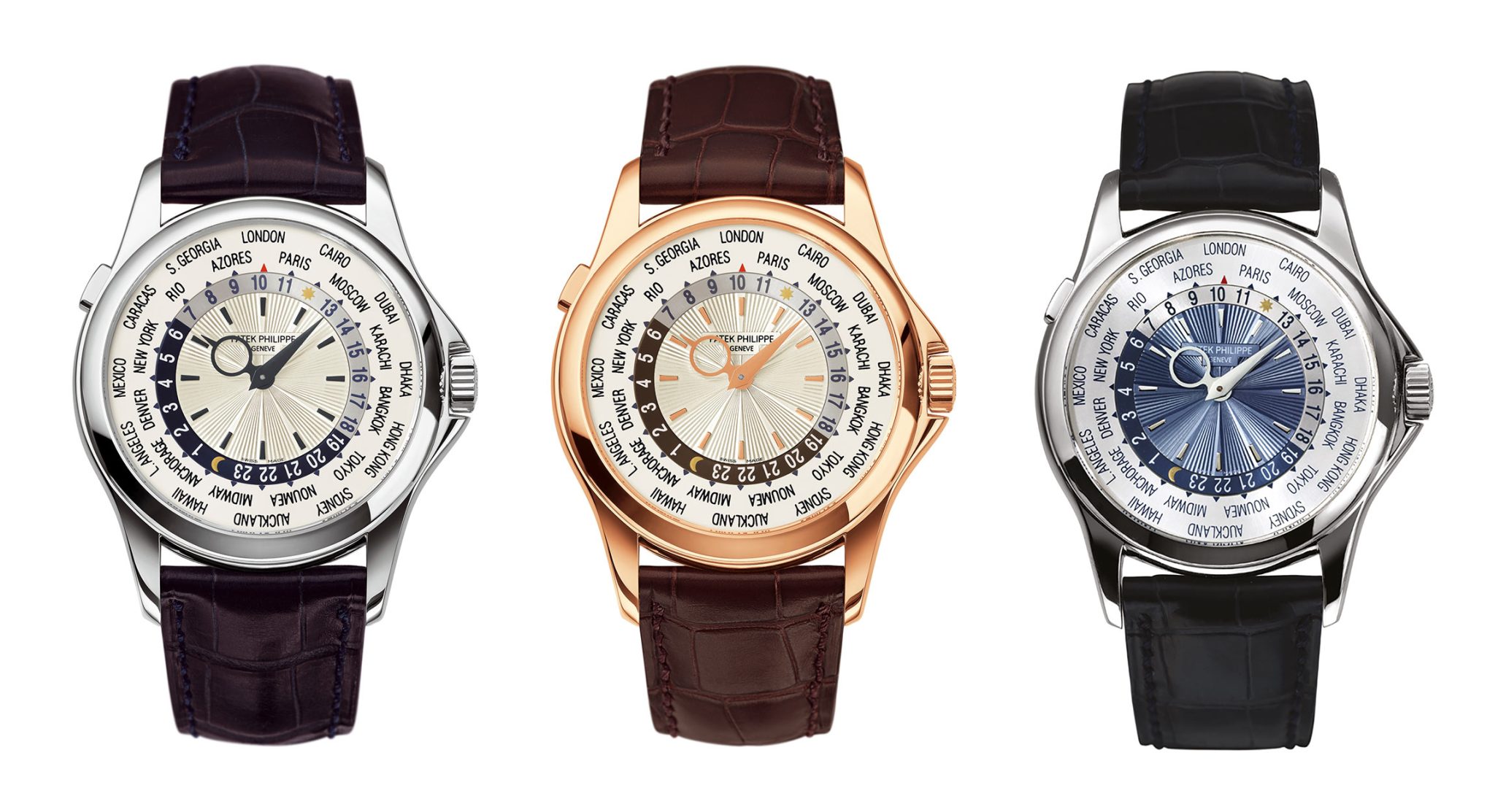
Patek Philippe World Time watches (from left to right)
Ref. 5130G-001, 5130R-001,5130P-001
Today’s current variety of models has ensured that there is a new group of collectors among Patek fans. There are those who focus completely on World Time watches, ignoring even the widespread enthusiasm for the Nautilus models, or the distinctive charm of the “Rare Handcrafts” models, with their perfect craftsmanship and uniqueness.
On a personal note, it was also a World Time watch that heightened the author of this article’s fascination for Patek. For the manufacture’s 175th anniversary in 2014, the Reference 5575 (among others) was introduced as a limited edition of 1,300 pieces. At its centre lies a moonphase display, mounted on a rotating mineral glass disc. This moon-and-star display is so perfectly in harmony with the white-gold case, the black dial, and the city names in white font, that one hardly needs contemplate about the popularity of this model. Even in 2014, only the best customers of the concessionaires were considered, and despite a 42,240-euro original selling price, more than 100,000 euros are now demanded on the secondary market for these flawless models.
In the face of such success, it must have been incredibly tempting for Patek to launch another unlimited model with a similar look and moonphase function. But if one thing is certain, it is that Patek Philippe, as a brand and manufacture, always remains unpredictable and never simply thinks opportunistically in the short term.
In any case, investment pieces like the one above by no means explain the appeal of these watches, which are in many ways so very different from the common notions of an aesthetically pleasing watch. They are more playful, as well as much smaller in size simply because of the many city names. If too much writing on the face is normally interpreted as a disadvantage, different rules apply in this watch category. Karachi, Auckland, La Paz – small watches, big world.
The best time of all: the here and now.
2021: The current collection
The Patek Philippe catalogue currently features the Reference 5230 as the latest pristine World Time watch, being available in white and rose gold. Particularly aesthetically pleasing is the hand-guillochéd braided pattern in the centre of the dial. Meanwhile, its case, with a diameter of 38.5 mm, is slightly smaller than that of its predecessor.
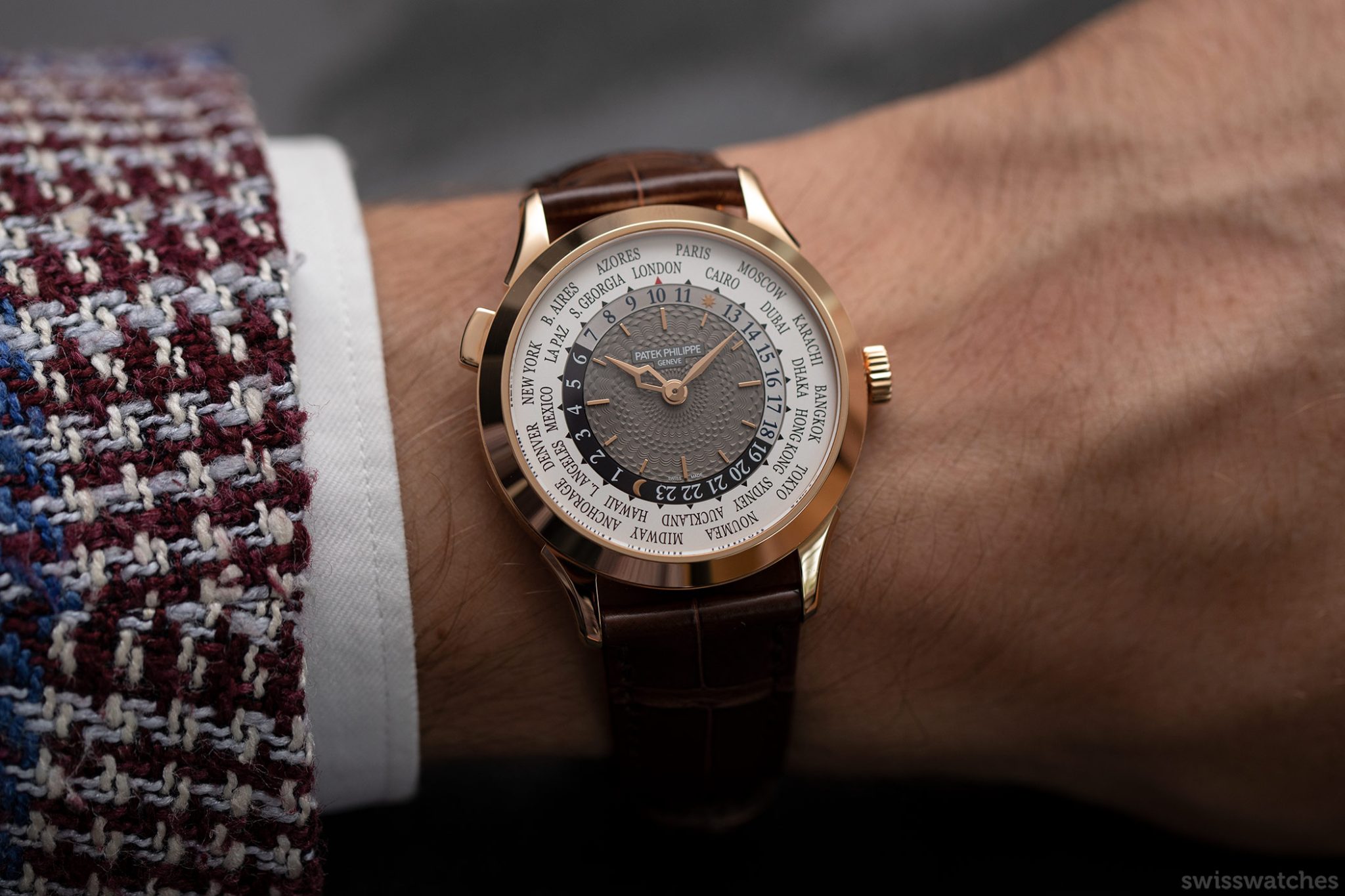
Patek Philippe Ref. 5230R-012
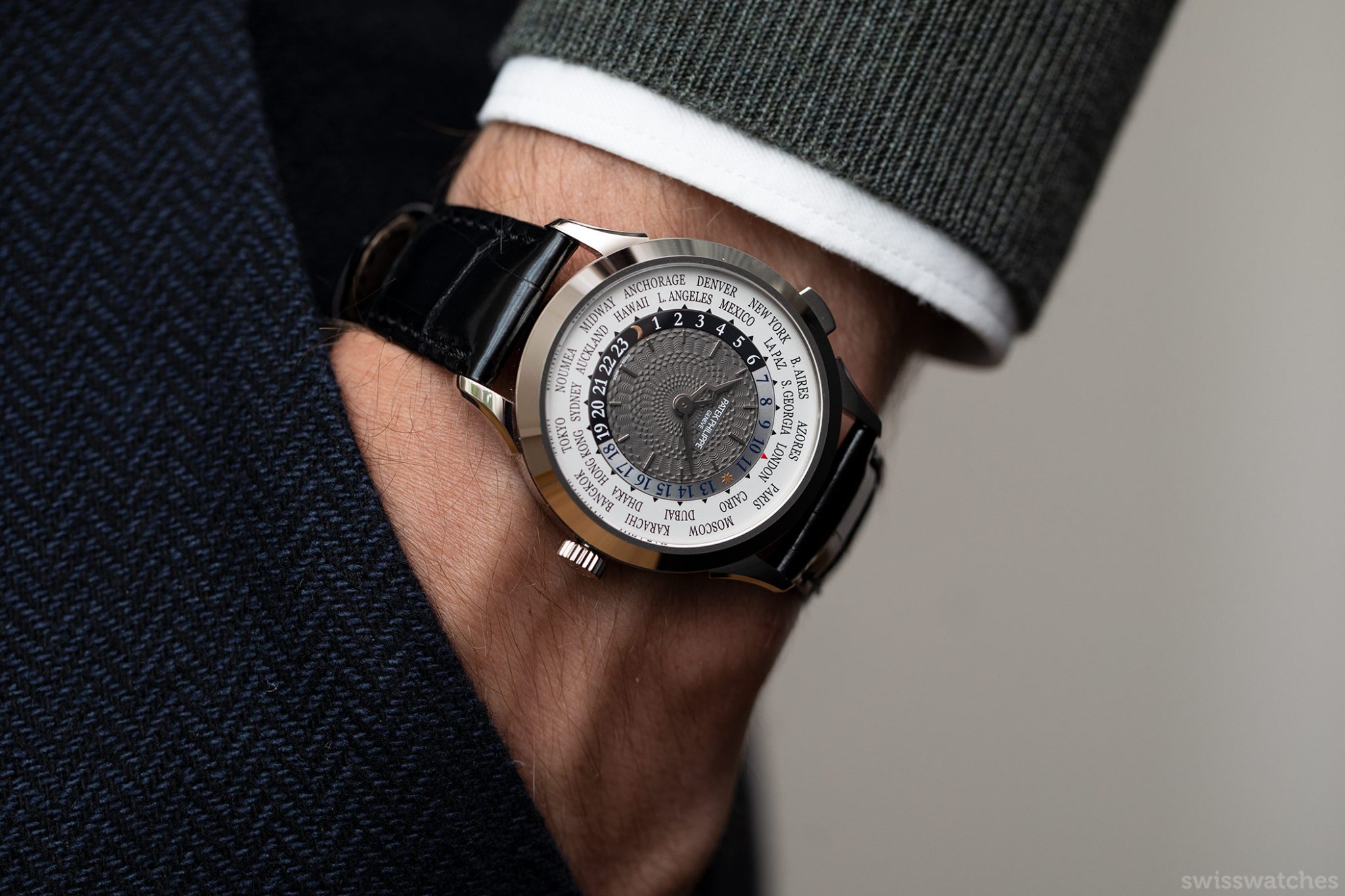
Patek Philippe Ref. 5230G-014
In addition, the yellow-gold 5231 is available with a cloisonné enamel world map. Its price of 68,360 euros is more than 20,000 euros higher than that of the guilloché World Time watches. At first, this seems like a big markup, but the detailed miniature world map, with its coloured enamel nuances, represents a special value in itself. So too do the ladies’ Reference 7130 models in white or rose gold, flaunting diamond bezels. All models remain powered by the 240 HU calibre.
Patek Philippe Ref. 5231J with a Cloisonné Enamel World Map
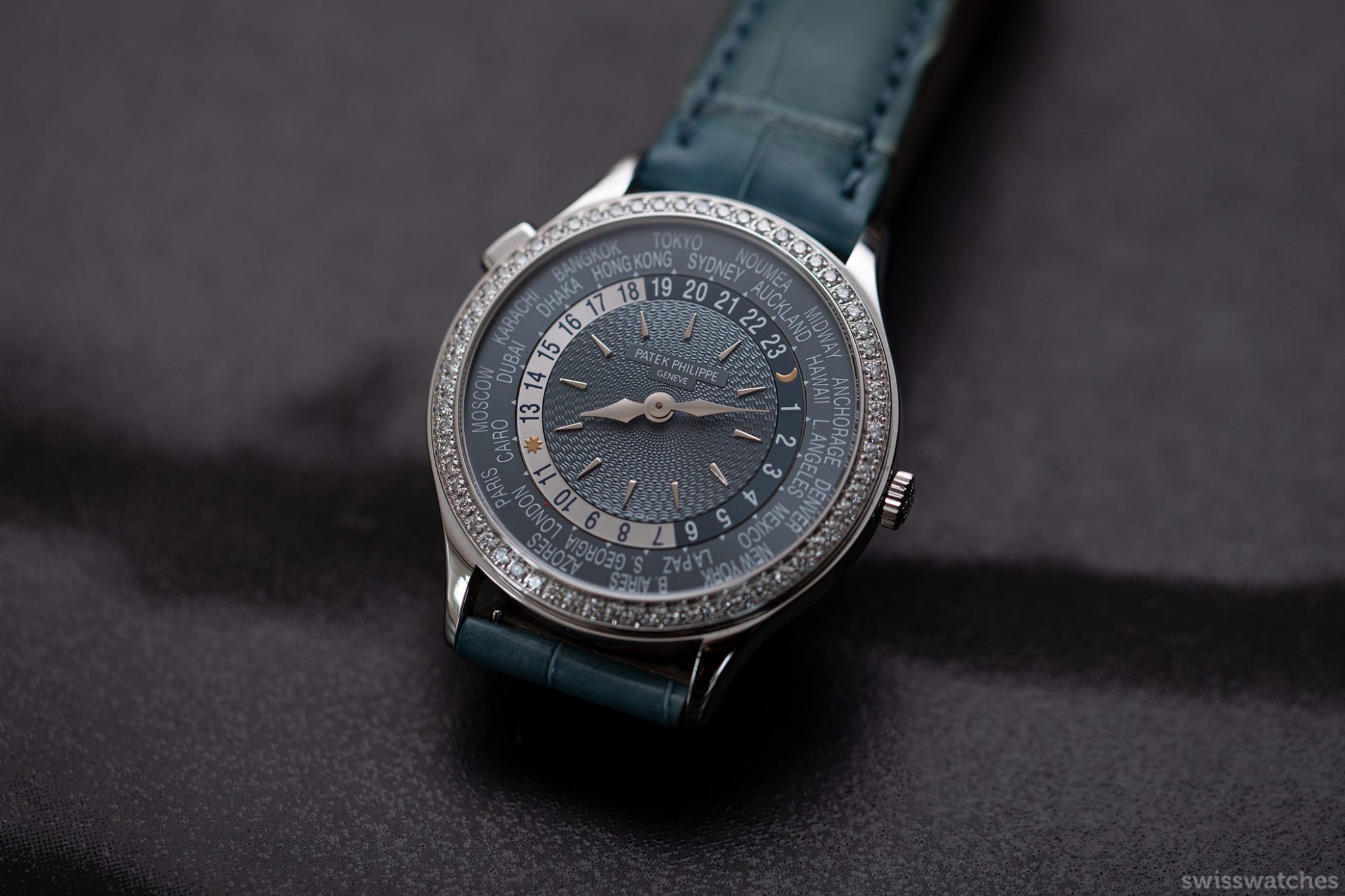

Patek Philippe world time watches:
Ref. 7130G-016 in white gold and Ref. 7130R-013 in rose gold
At the pinnacle of Patek Philippe craftsmanship in connection with World Time watches is currently the Reference 5531R. This Grande Complication, priced at around 500,000 Swiss francs, combines the World Time function with a minute repeater. It is the first minute repeater to always strike the local time – prior to this, watches of its kind announced only the home time with sound. The automatic calibre R 27 HU was specially developed to achieve this milestone. The gongs on this model are not mounted on the plate, but rather unusually, on the inside of the case. Aesthetically, the 42 mm model mesmerises its wearer with cloisonné enamel in the centre of the dial, which depicts the Lavaux vineyard landscape lying upon Lake Geneva.
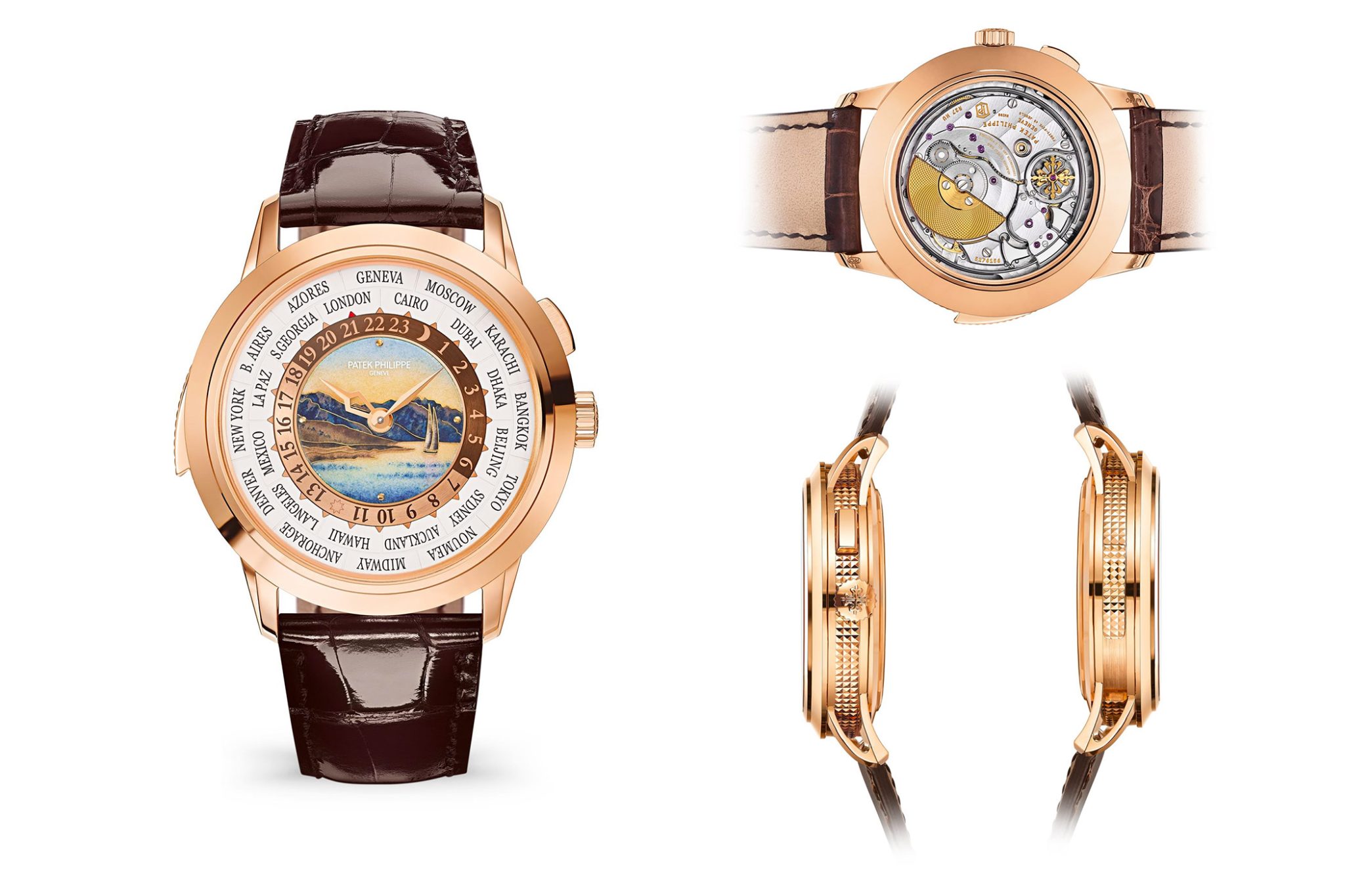
Patek Philippe Minute Repeater, World Time Watch:
Grandes Complications Ref. 5531R-012
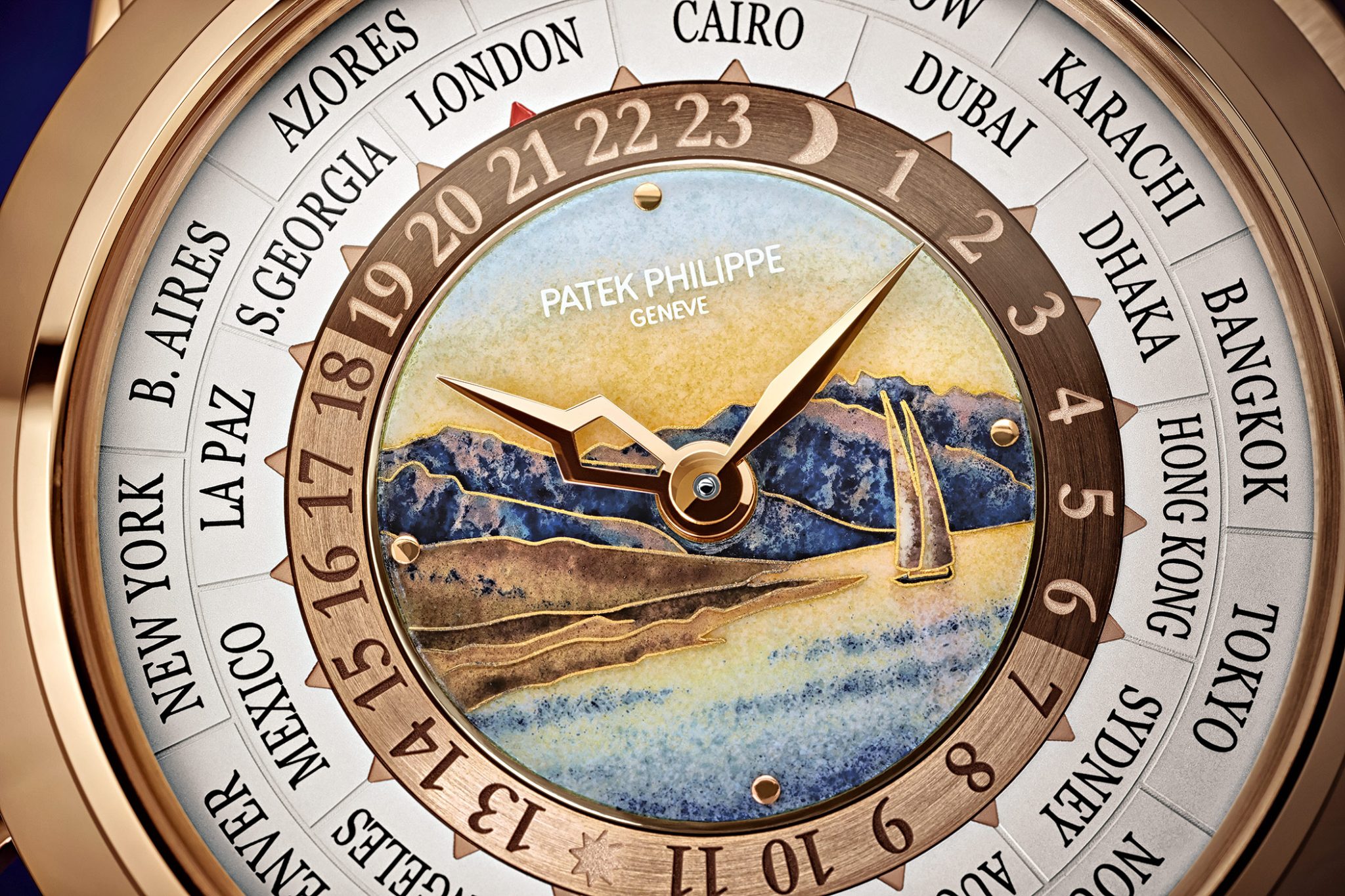
One timepiece still remains – and is a very special one considering the history of Patek Philippe World Time watches: the Reference 5930G, which combines the World Time mechanism with a chronograph, following its presentation in 2016. As we learned earlier: in 1940, the Reference 1415-1 HU with chronograph function had been made as a unique piece at the request of a customer. At that time it appeared in yellow gold, with a pulsometer scale and 33 place names on the bezel. Following the tradition of this exact watch, the 5930G was developed. It features the popular colour combination of a white-gold case and blue dial, a 30-minute counter at six o’clock, and a 24-hour plate with day/night indicator and a plate with 24 place names on the edge of the dial. Reference 5930G for the first time housed the automatic calibre CH 28-520 HU, a flyback-chronograph based on the development of a chronograph calibre.
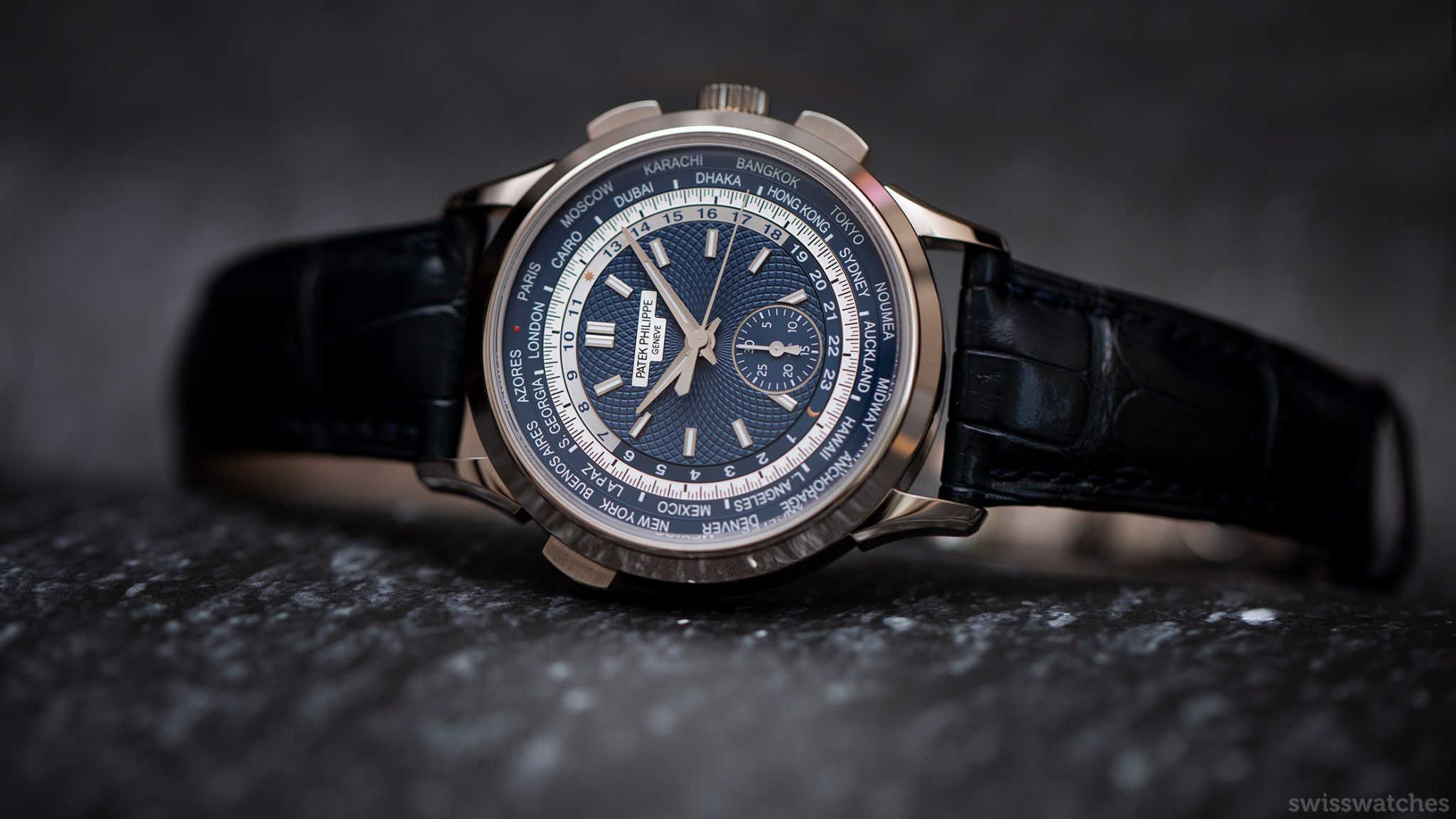
Patek Philippe World Time watch Ref. 5930G-010 with a Flyback Chronograph
Fans of the brand will know that even the best photographs of the company’s timepieces can never fully do justice to the incomparable presence of a Patek Philippe in reality. In the case of the 5930G, for example, the structure of the guilloché centre of the dial is completely captivating, while the colour play of the white-gold case plus the combination of blue, white, silver, and black on the dial unite to create something that radiates both perfection and passion.
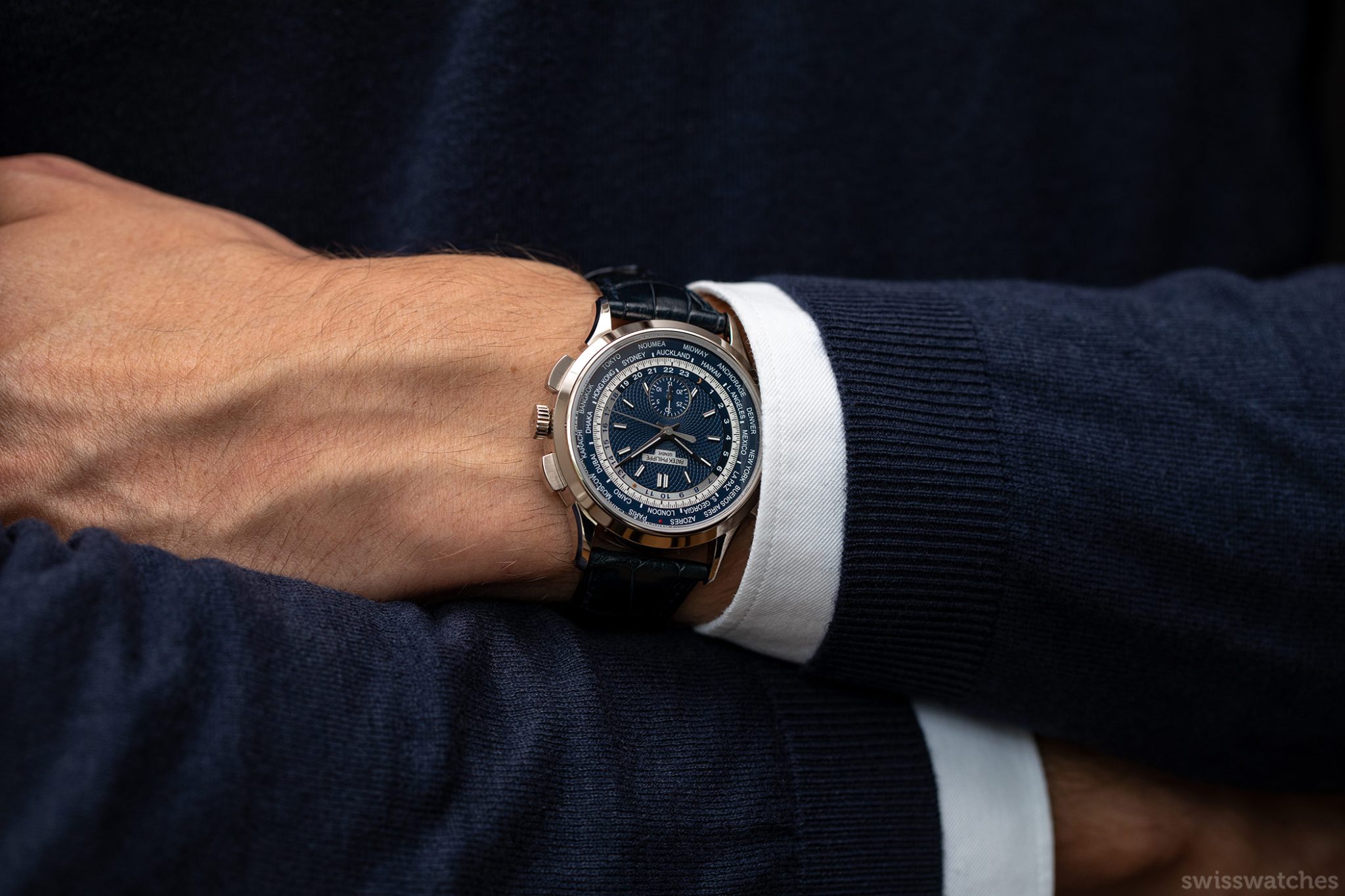
The Ref. 5930 was inspired by a unique piece from 1940
Since its introduction, this new model, which is firmly anchored in the manufacture’s history, has only been available as this variation, as well as a Singapore Edition (Ref. 5930G-011), limited to 300 pieces, with a red guilloché dial. This year, a platinum version followed. The guilloché showcased on the centre of the dial on the 5930P-001 is green. Green is known to be the new blue; the on-trend colour of the moment. But just as the 5930G isn’t just another blue watch, the green of the platinum 5930’s radiantly fluctuating emerald-green hue isn’t just of the time, but has a far wider appeal. The current desirability of it is, by all accounts, enormous; especially since among the friends of the brand there is the “PPP” group – collectors of everything Patek Philippe makes in platinum.
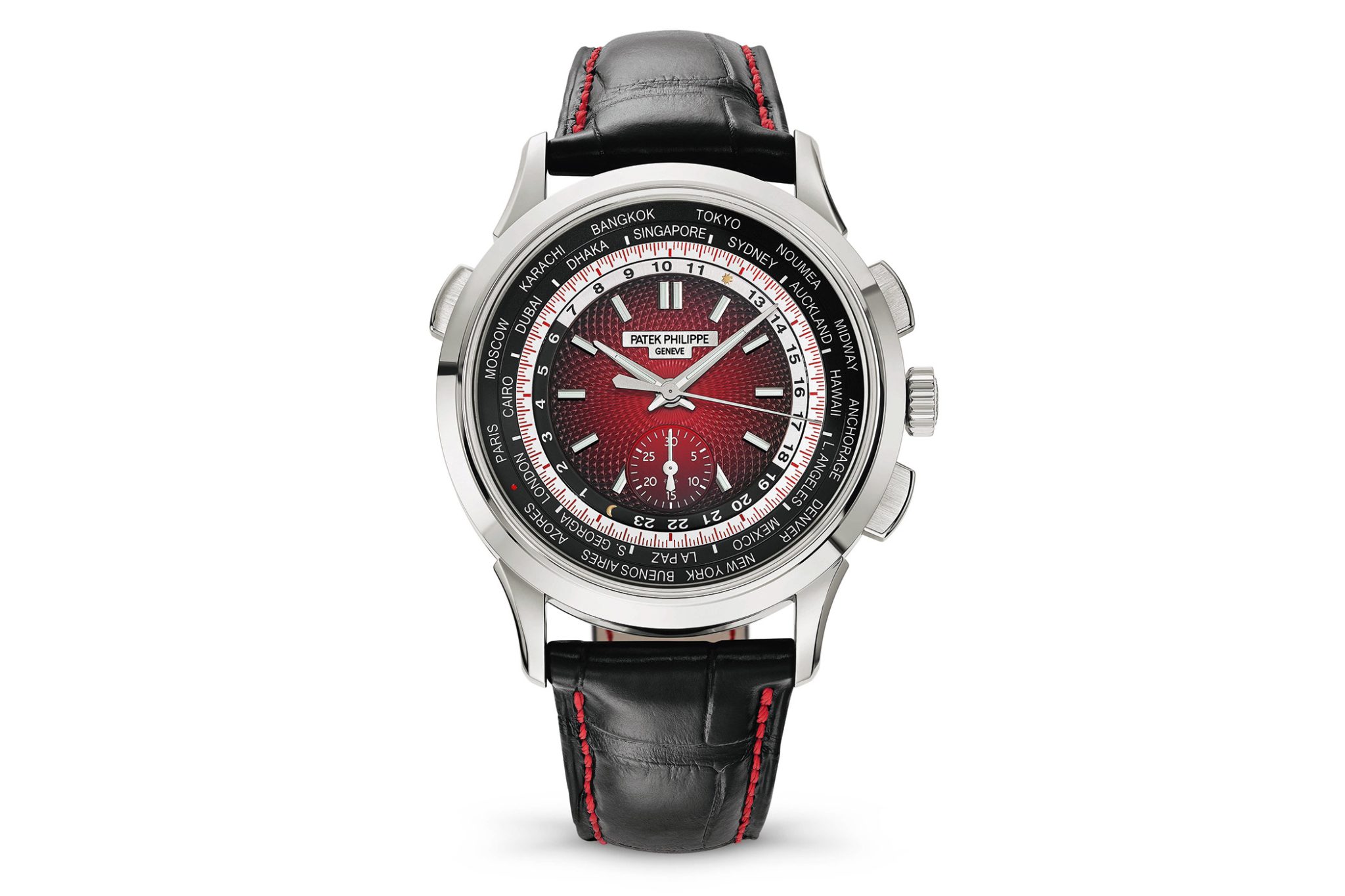
Patek Philippe World Time watch Ref. 5930G-011 Singapur-Edition
Apart from its great history and current colour scheme, the 5930 also represents the most up-to-the-minute view of the world’s time zones according to Patek Philippe: the cities of Buenos Aires, La Paz, Sao Paulo and Brisbane make an appearance on the time zone ring, while Rio de Janeiro and Caracas have disappeared, for example.
Patek Philippe Ref. 5930P-001 in platinum with a green dial and green leather strap
All in all, this Reference is a delightful crosser of frontiers. Combining the two “Patek-typical” – but at the same time visually very dominant – World Time and chronograph complications to appear appealing is a task in itself. This was not only resolved very tastefully, but additionally, the watch is also extremely easy to read – not least for a 39.5 mm model with so many different horological features. Aesthetically speaking, the World Time complication dominates the watch. The new green execution of Reference 5930 also houses the automatic calibre 28-520 HU.
A World Time watch from Patek Philippe combines many things that enthusiasts love: craftsmanship and tradition, innovation and creativity, as well as a good dose of adventurous spirit. Anyone caught wearing one of these watches and gazing, enraptured, at the dial, has a good excuse for doing so: after all, what happens around the world is something eternally of interest to us all.
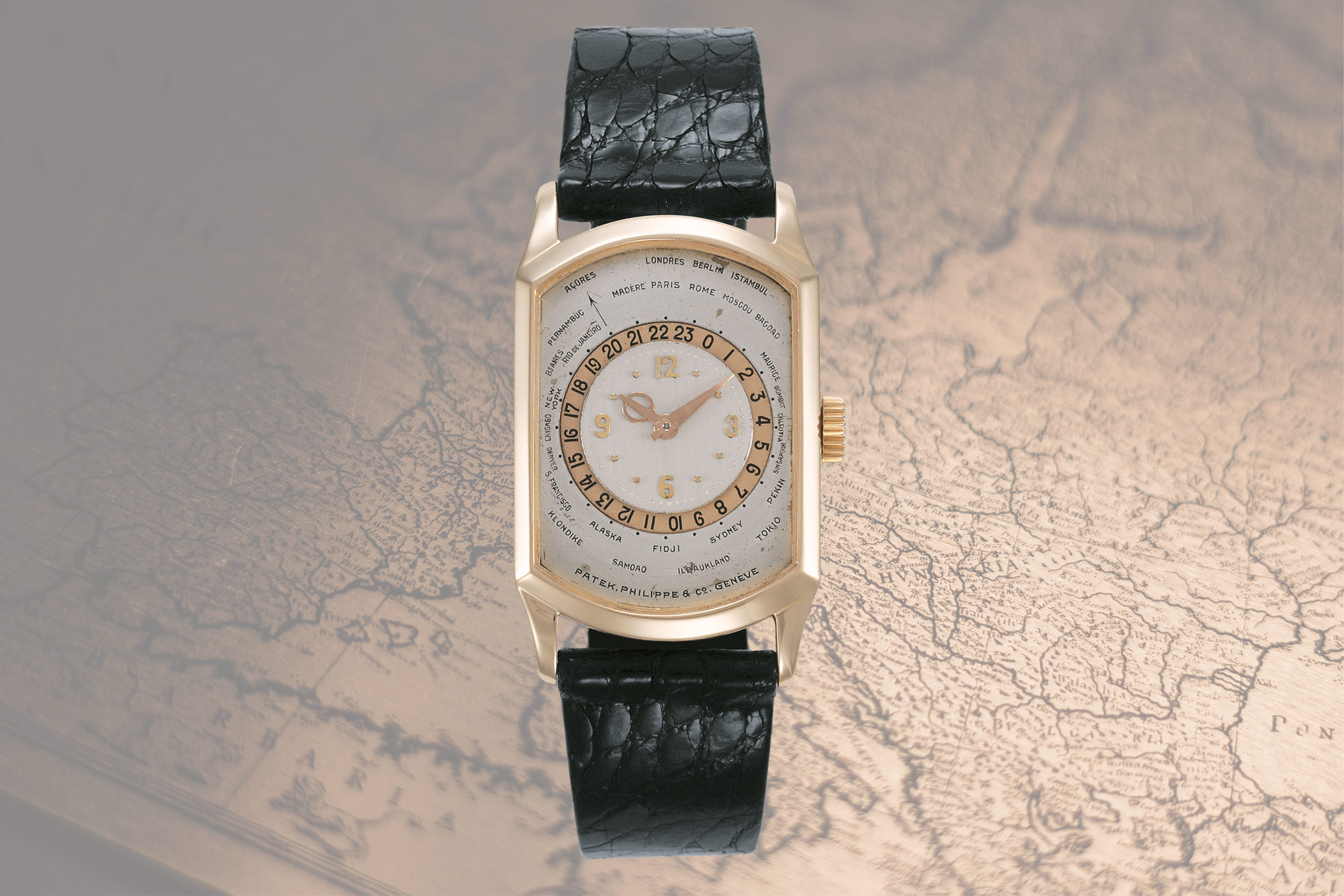
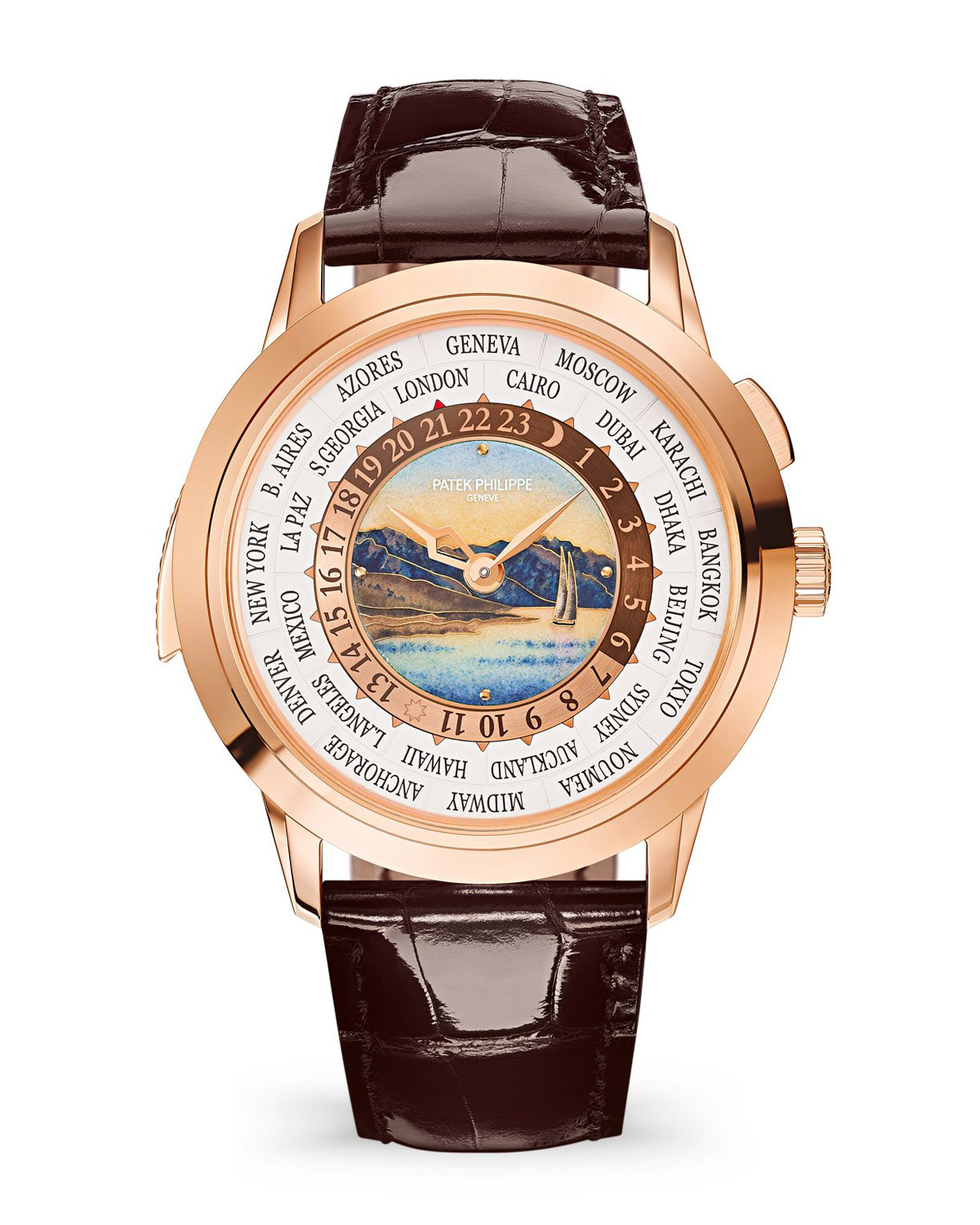
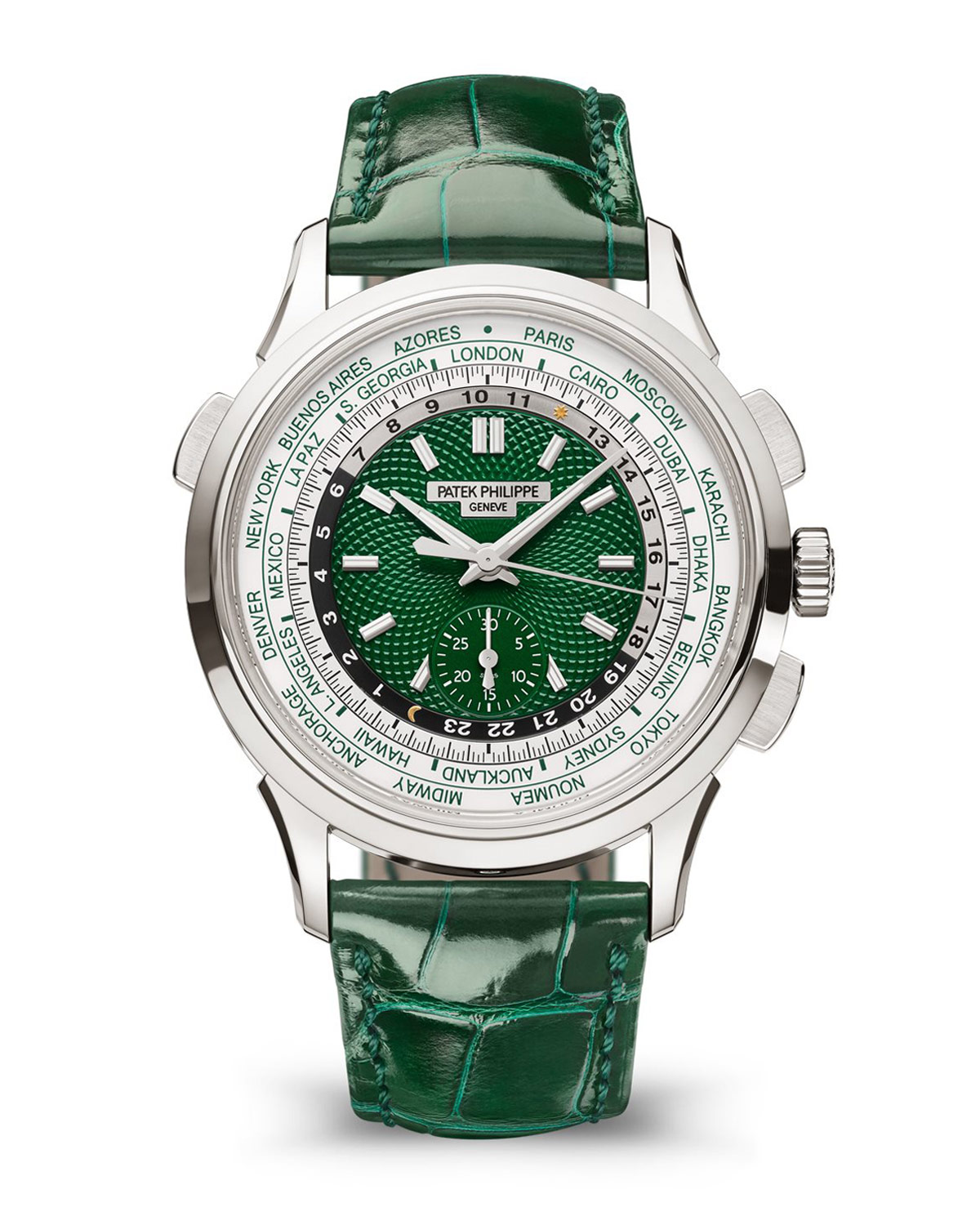
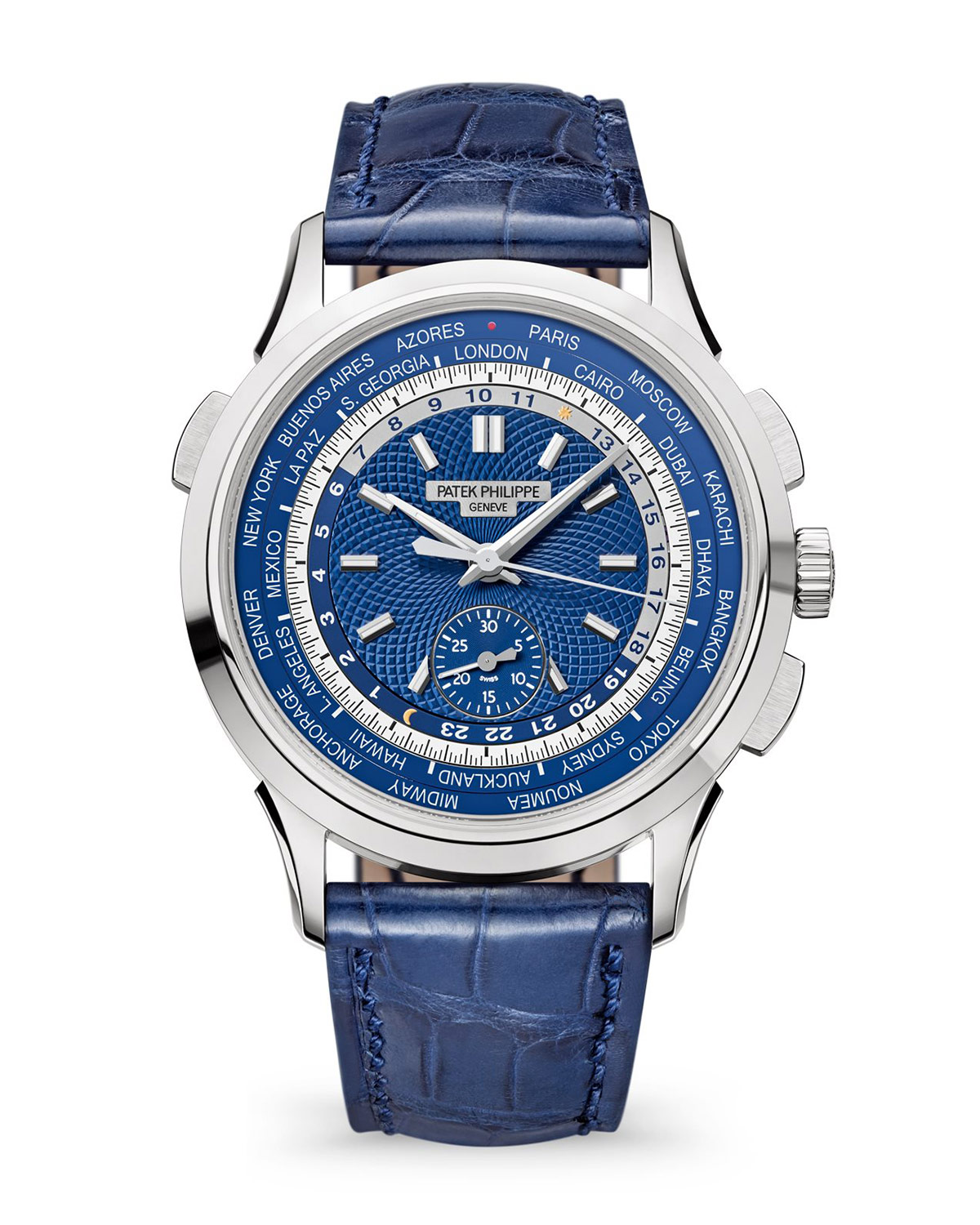
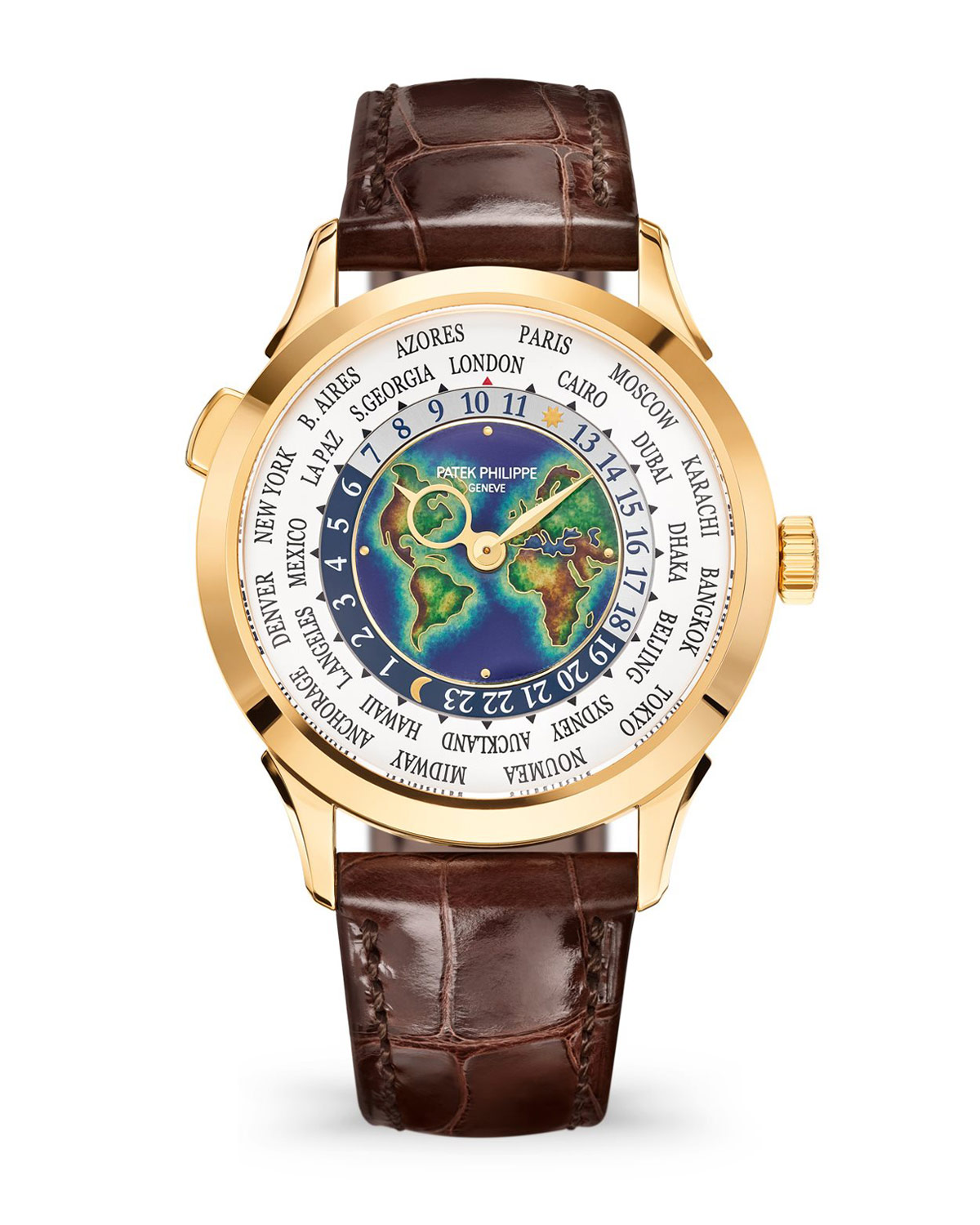
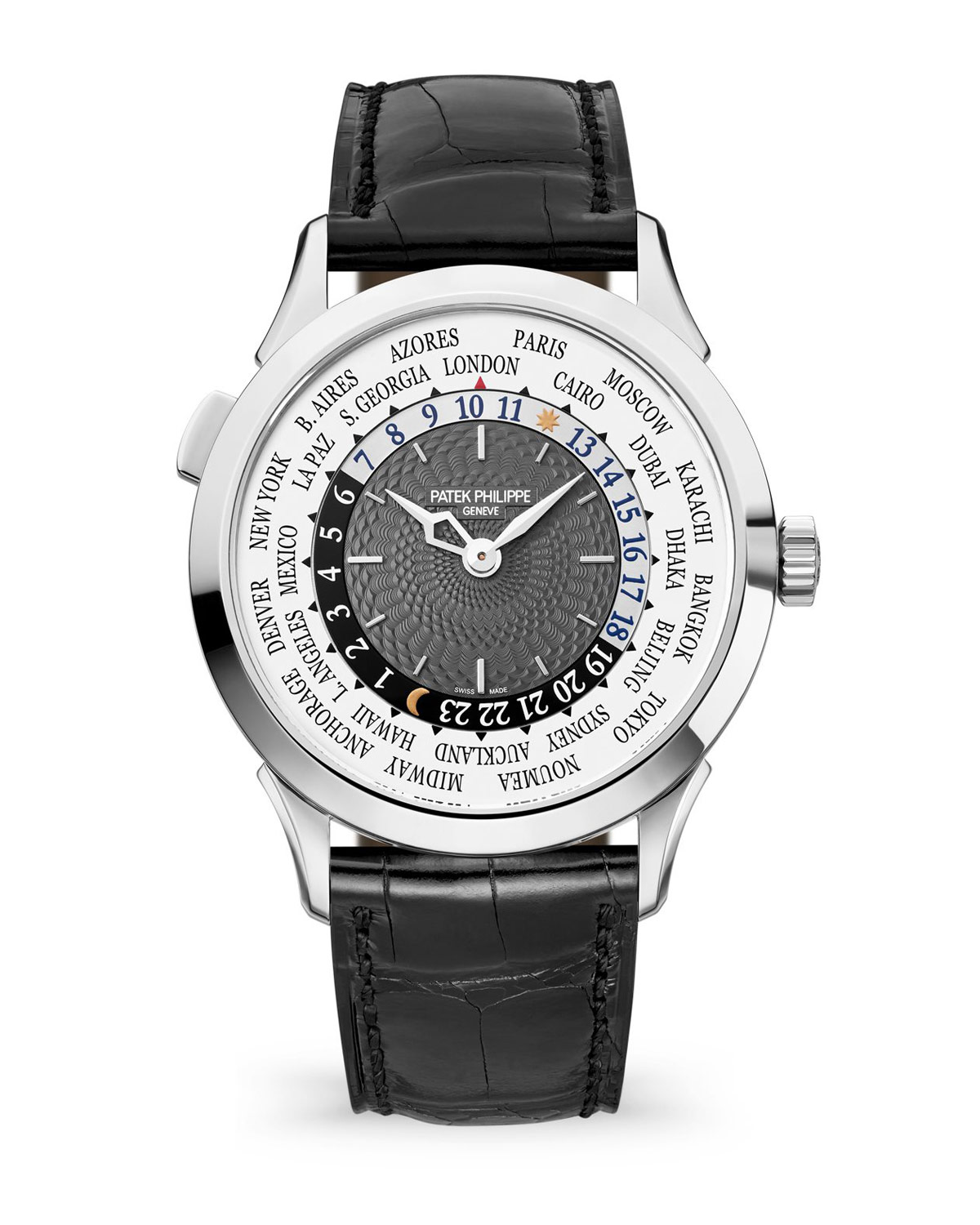
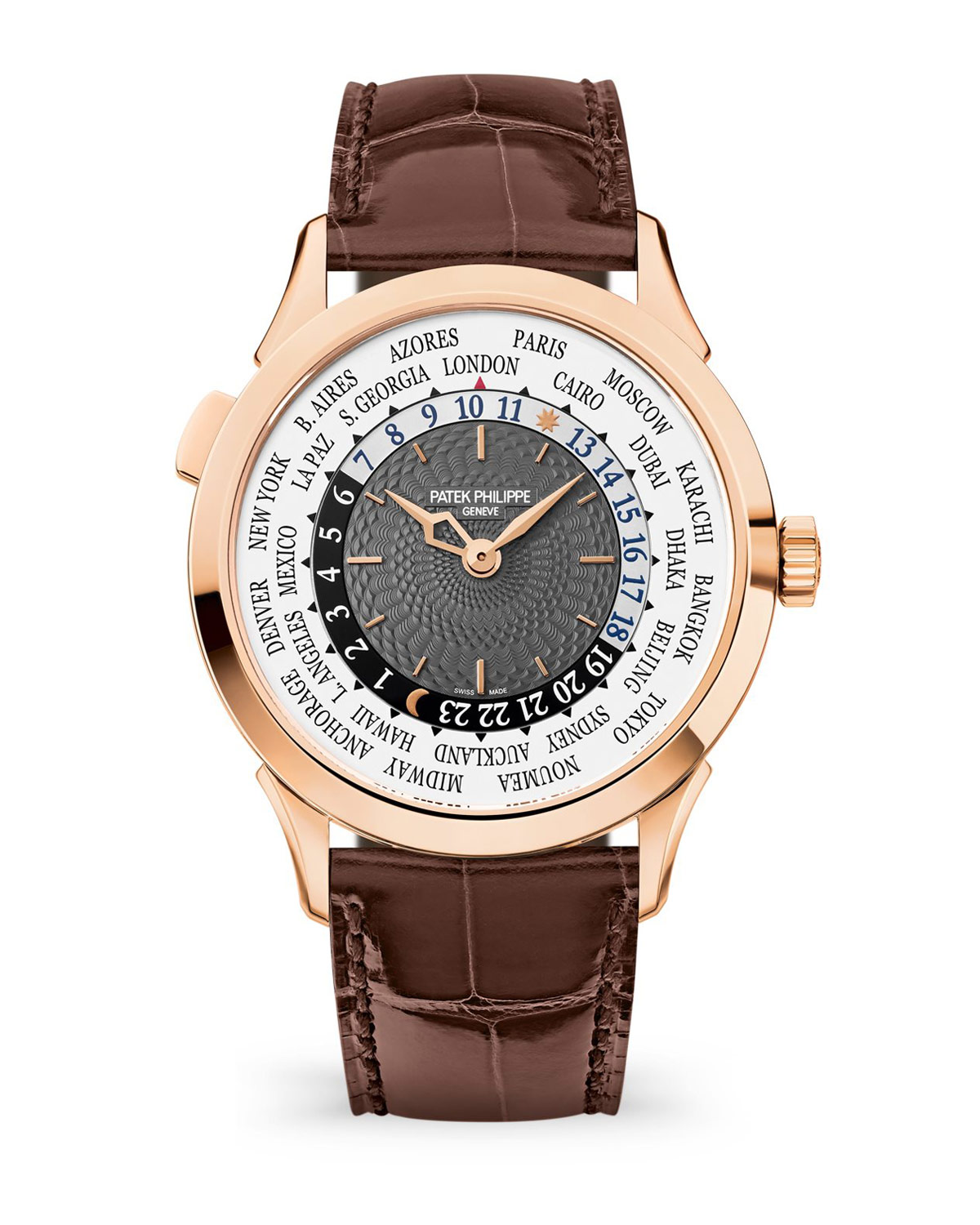
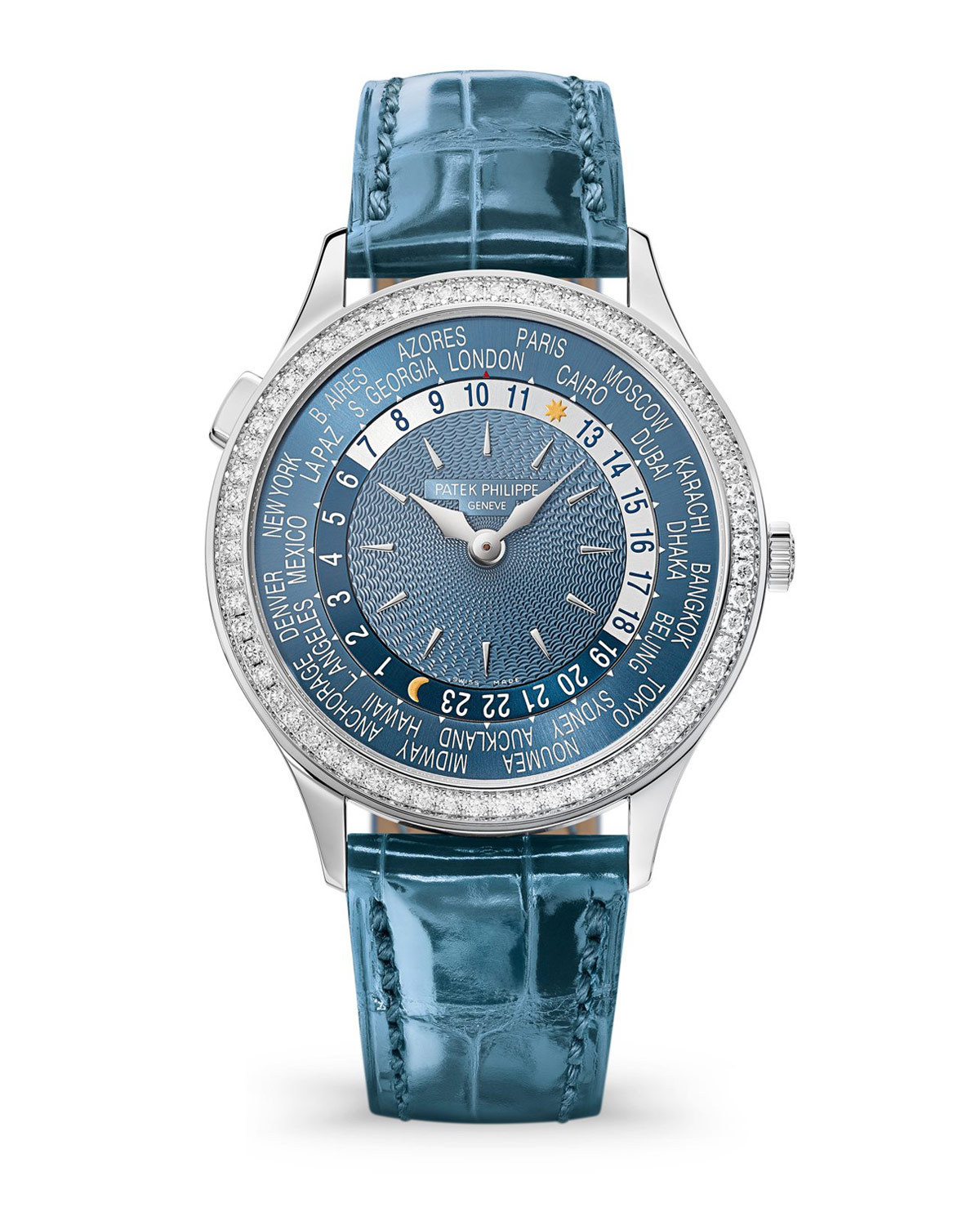
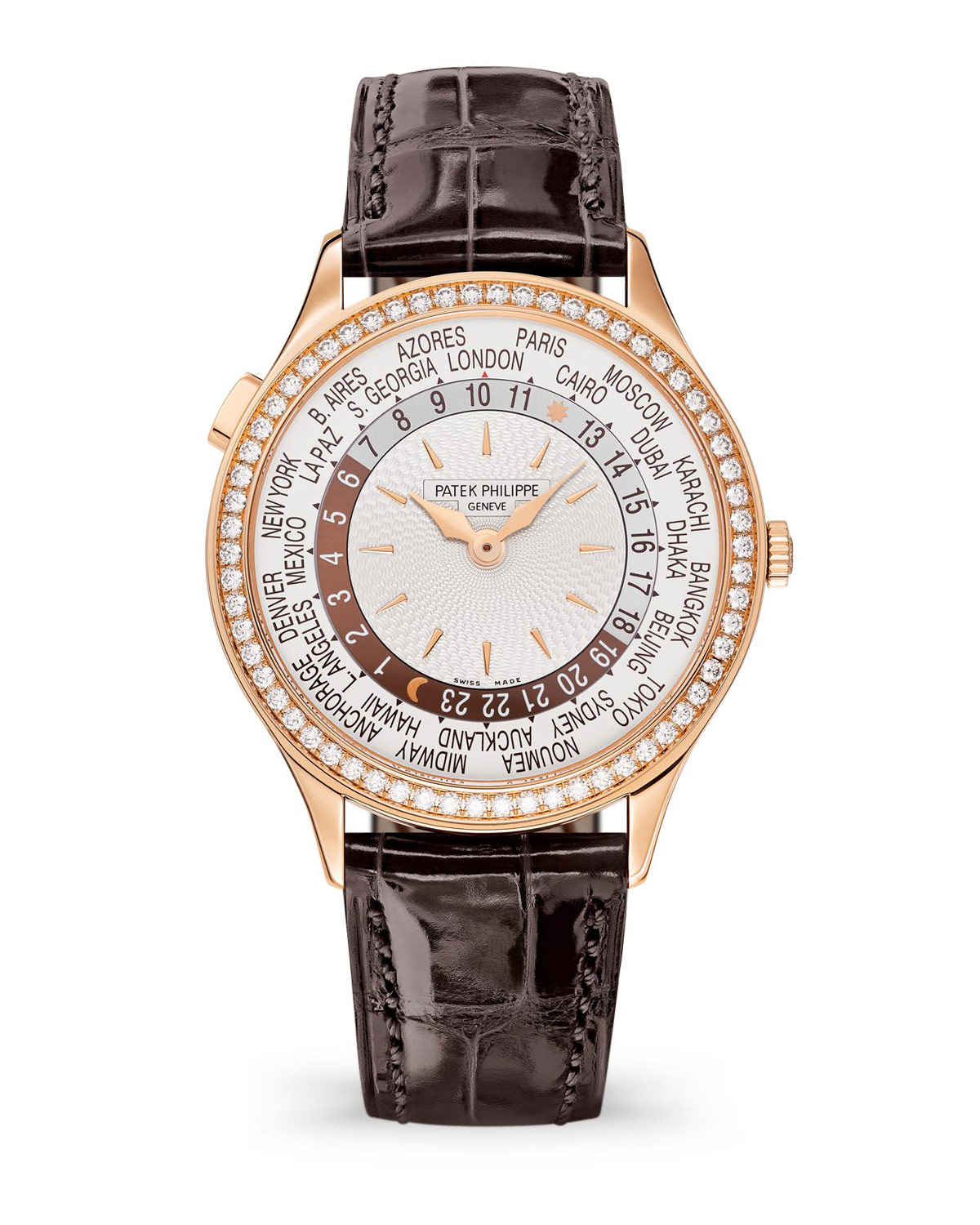
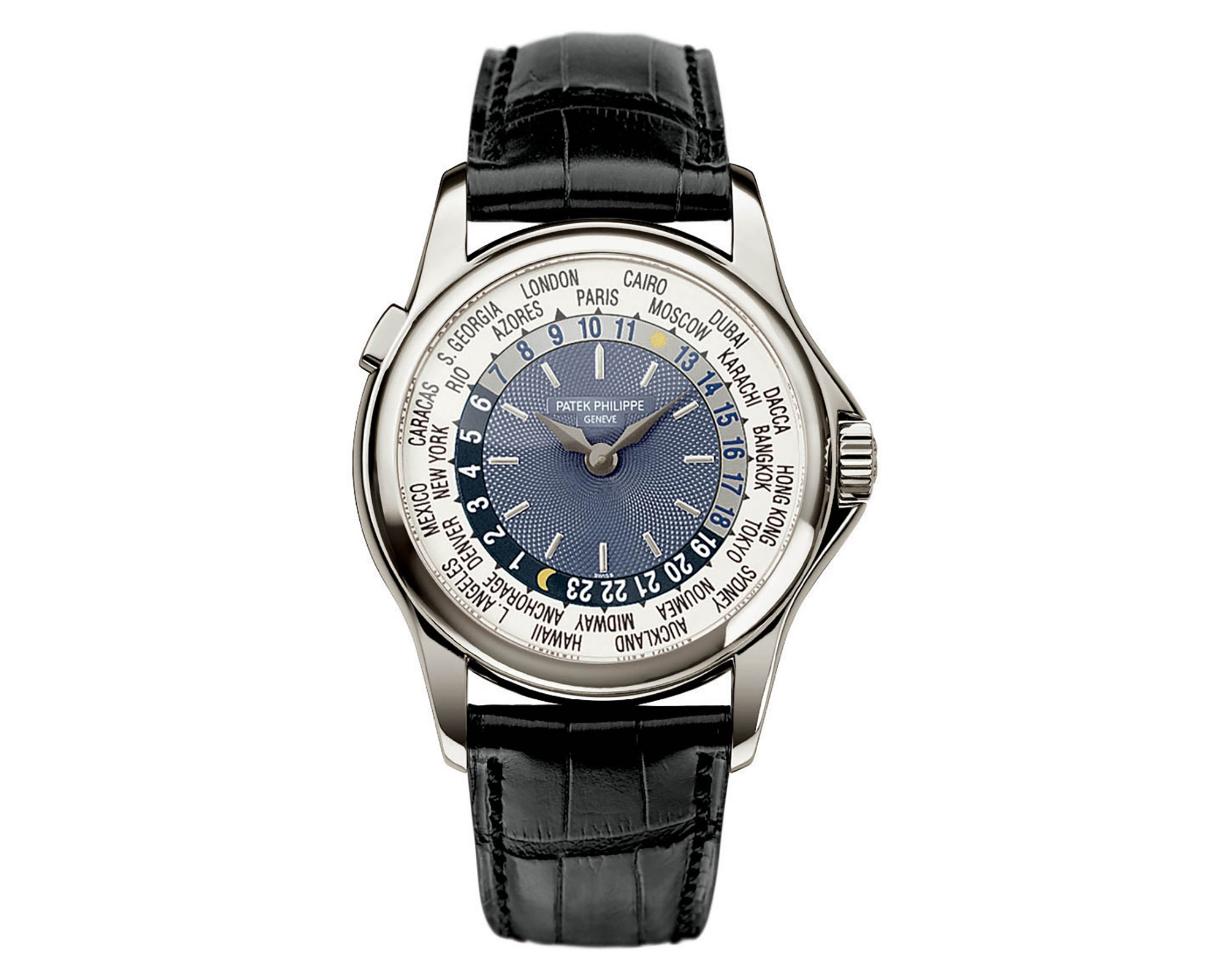
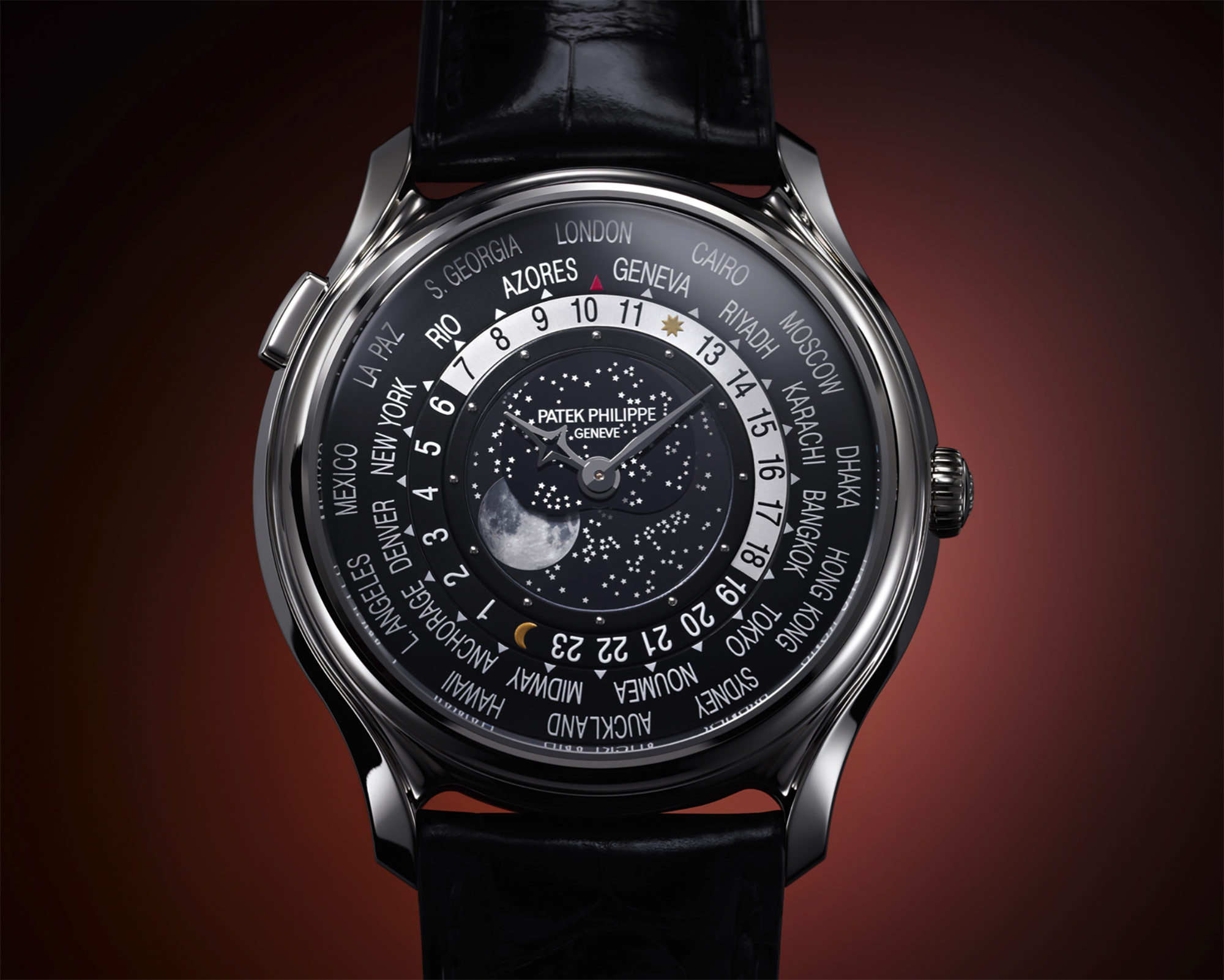
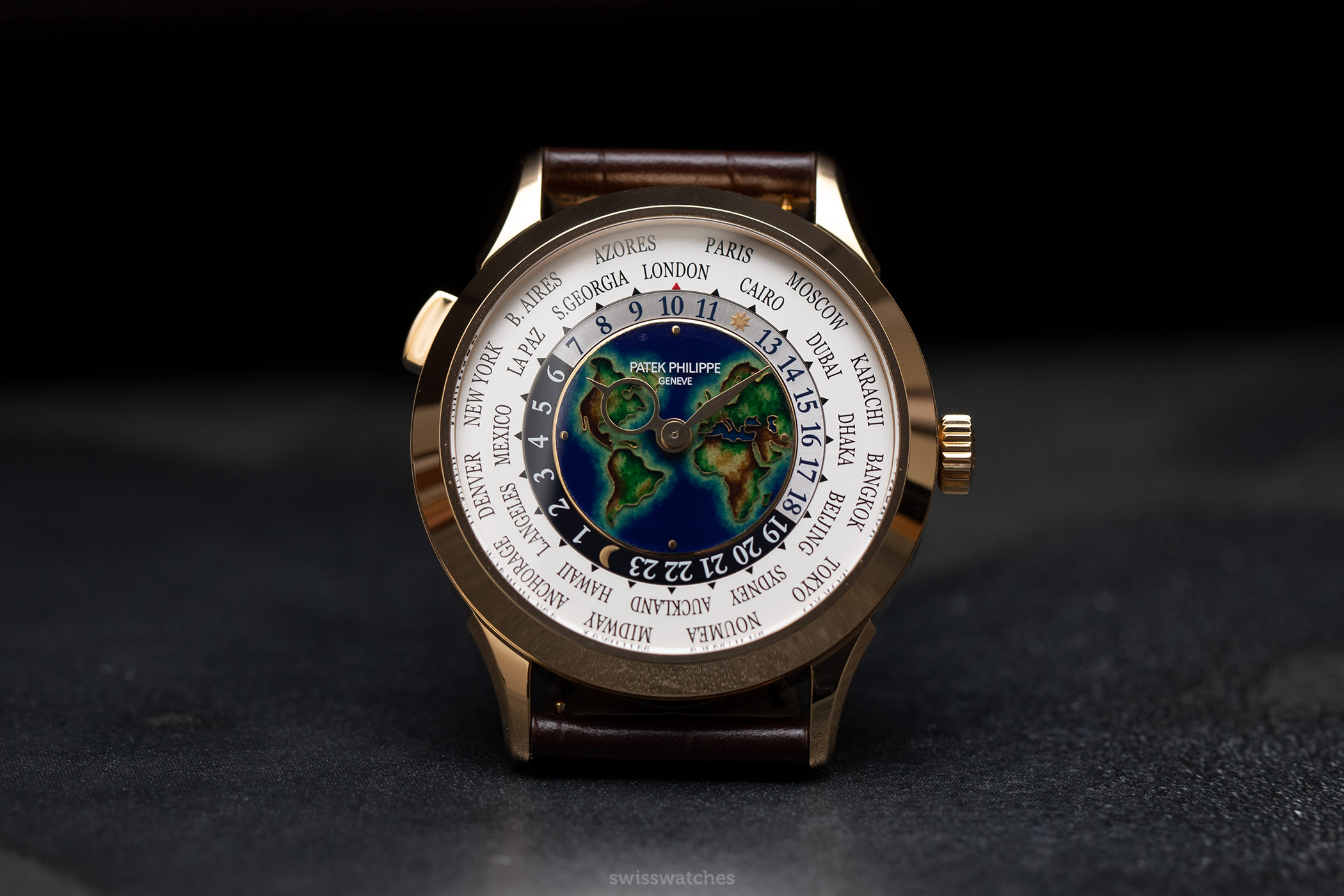
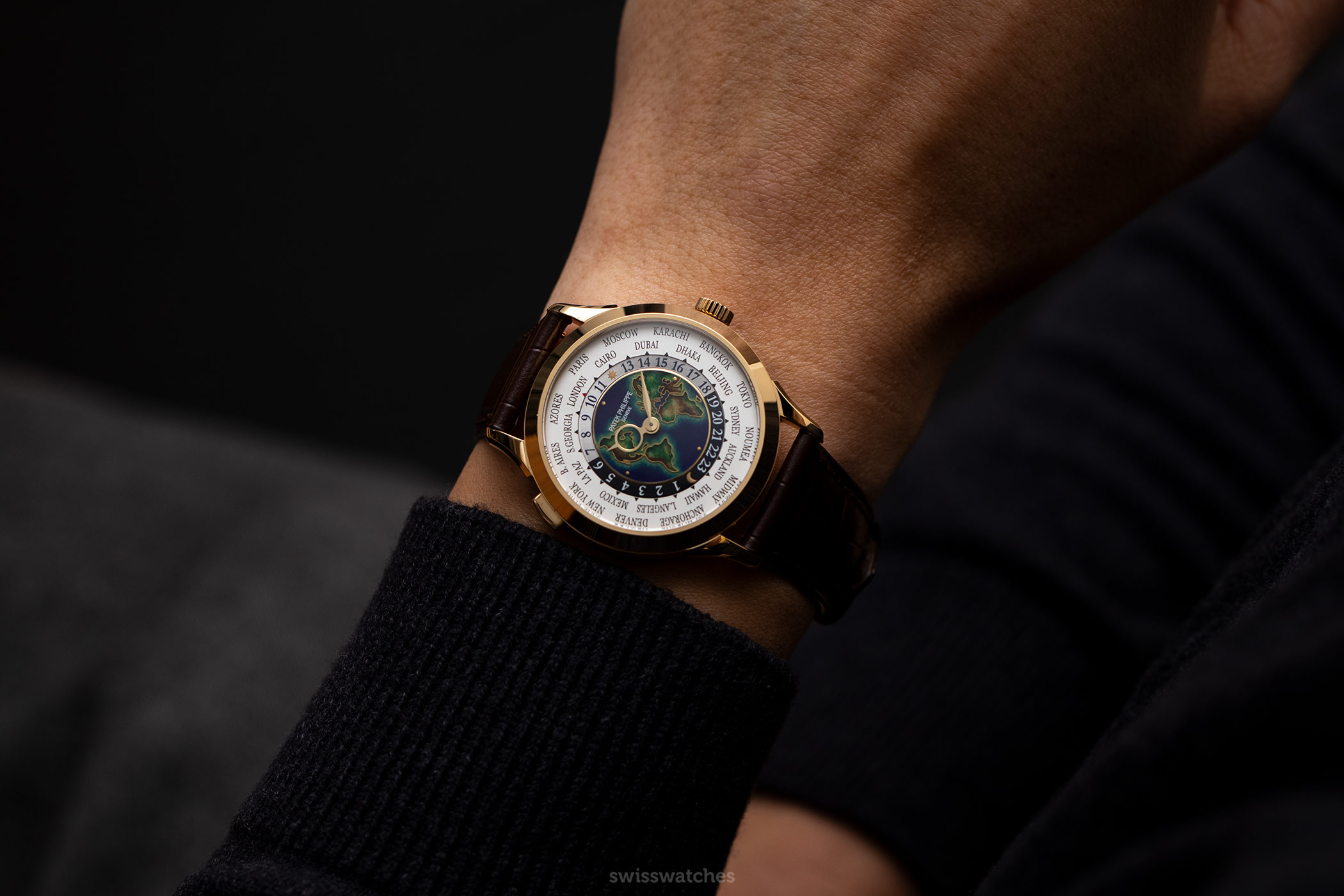
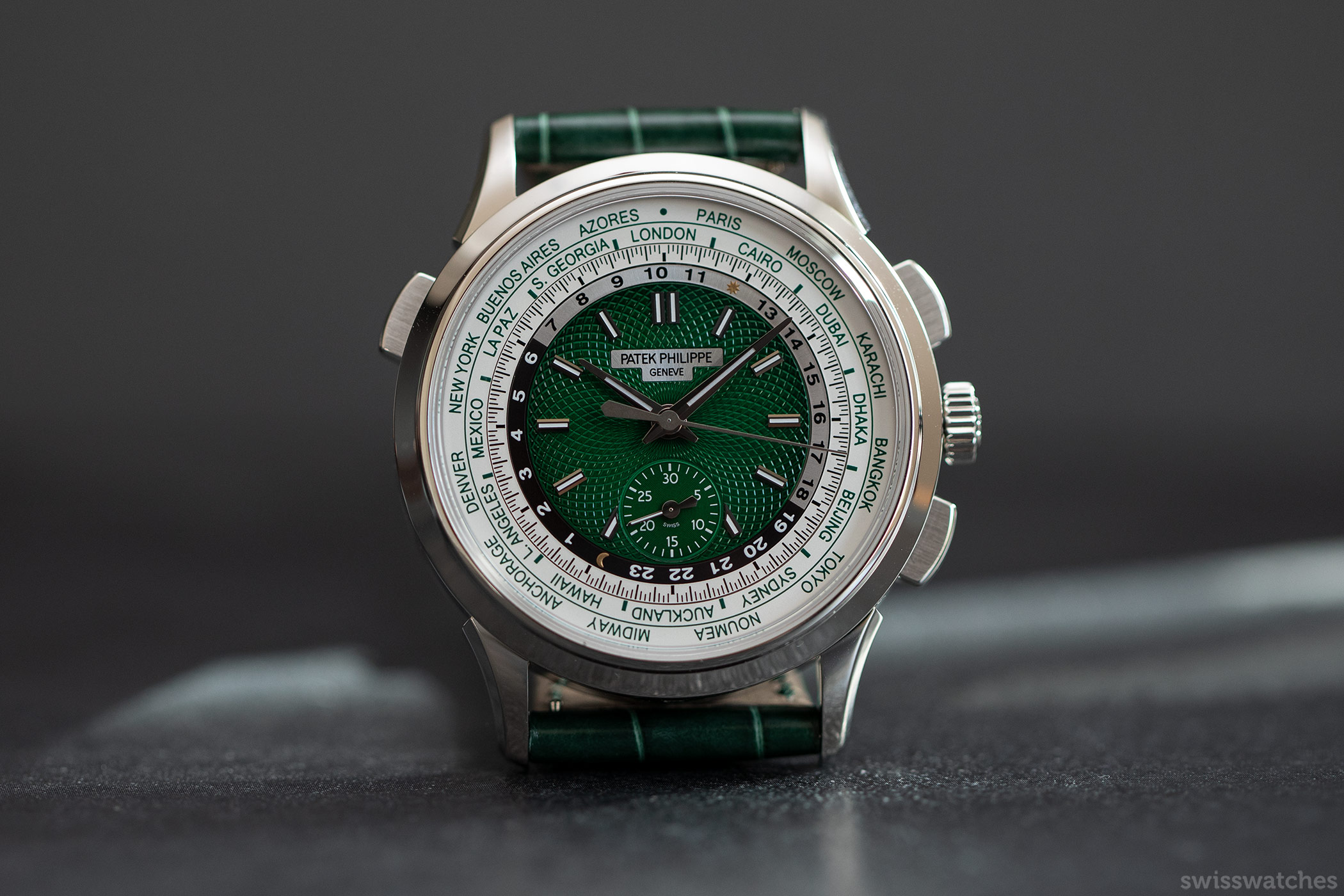
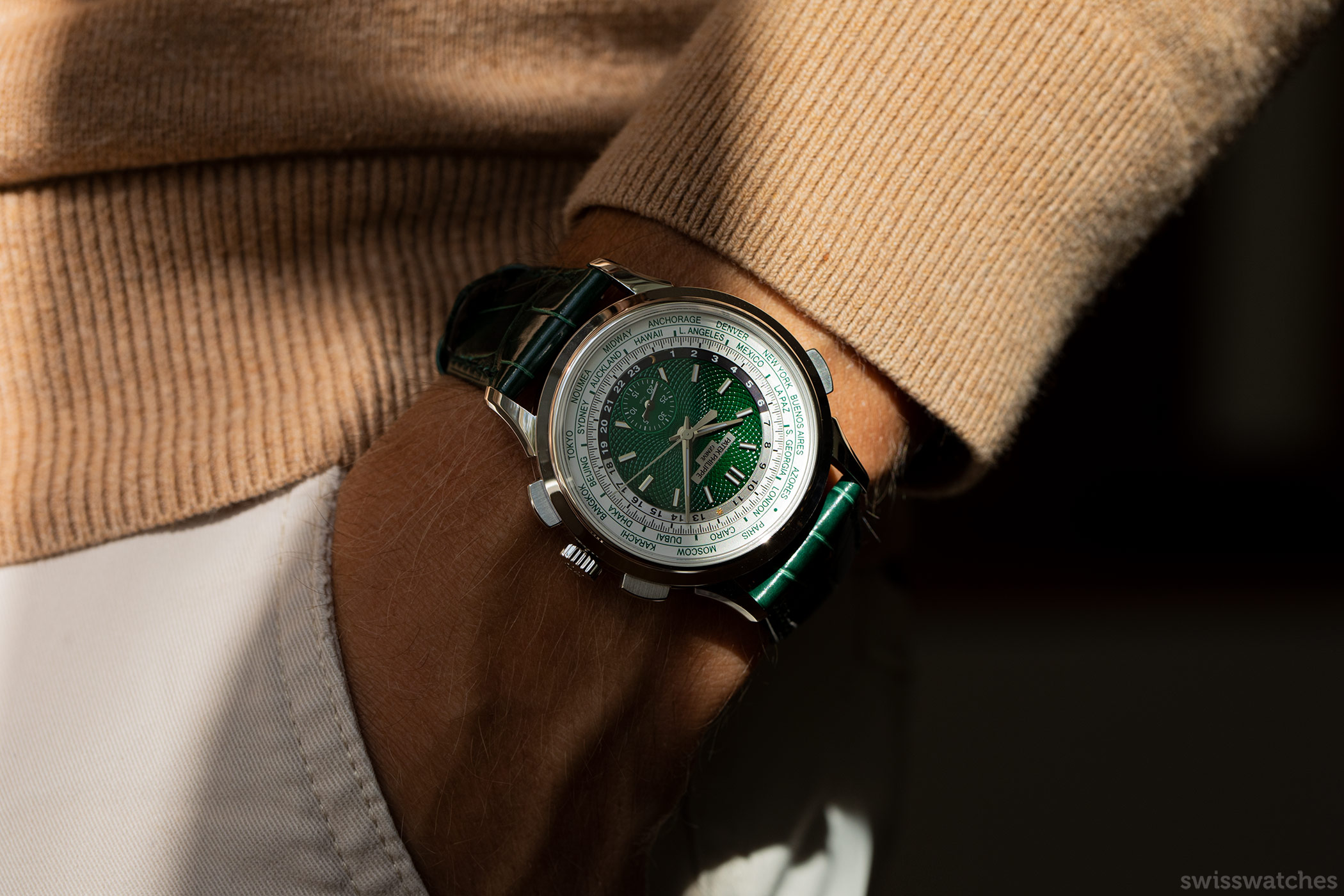


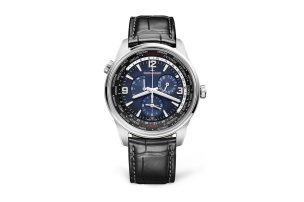

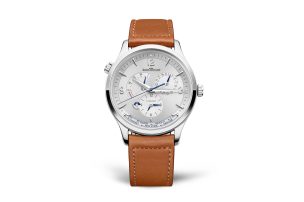
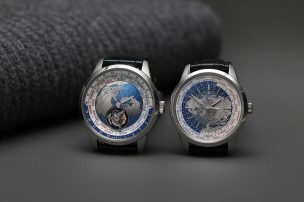

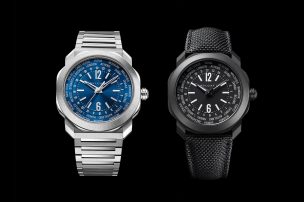
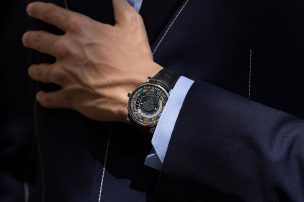
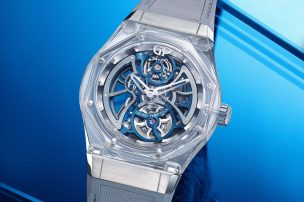
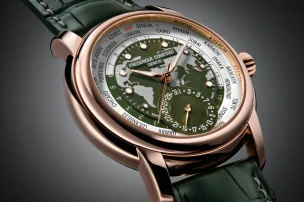
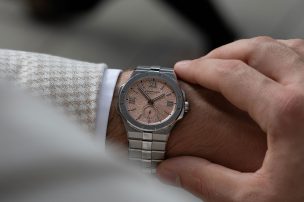
[…] case. That watch laid the groundwork for nearly a century of elegant, mechanically sophisticated world timers that have impressively maintained a cohesive design aesthetic throughout its […]